List of Indigenous peoples
This article has multiple issues. Please help improve it or discuss these issues on the talk page. (Learn how and when to remove these messages)
|
There is no generally accepted definition of Indigenous peoples,[a][1][2][3] although in the 21st century the focus has been on self-identification, cultural difference from other groups in a state, a special relationship with their traditional territory, and an experience of subjugation and discrimination under a dominant cultural model.[4]
Estimates of the population of Indigenous peoples range from 250 million to 600 million.[5] There are some 5,000 distinct Indigenous peoples spread across every inhabited climate zone and inhabited continent of the world.[6][7] Most Indigenous peoples are in a minority in the state or traditional territory they inhabit and have experienced domination by other groups, especially non-Indigenous peoples.[8][9] Although many Indigenous peoples have experienced colonization by settlers from European nations,[10] Indigenous identity is not determined by Western colonization.[4]
The rights of Indigenous peoples are outlined in national legislation, treaties and international law. The 1989 International Labour Organization (ILO) Convention on Indigenous and Tribal Peoples protects Indigenous peoples from discrimination and specifies their rights to development, customary laws, lands, territories and resources, employment, education and health.[11] In 2007, the United Nations (UN) adopted a Declaration on the Rights of Indigenous Peoples including their rights to self-determination and to protect their cultures, identities, languages, ceremonies, and access to employment, health, education and natural resources.[12]
Indigenous peoples continue to face threats to their sovereignty, economic well-being, languages, cultural heritage, and access to the resources on which their cultures depend.[13] In the 21st century, Indigenous groups and advocates for Indigenous peoples have highlighted numerous apparent violations of the rights of Indigenous peoples.Definition
[edit]

Indigenous communities, peoples, and nations are those which have a historical continuity with pre-invasion and pre-colonial societies that developed on their territories, and may consider themselves distinct from other sectors of the societies now prevailing on those territories, or parts of them. They form at present non-dominant sectors of society and are determined to preserve, develop and transmit to future generations their ancestral territories, and their ethnic identity, as the basis of their continued existence as peoples, in accordance with their own cultural patterns, social institutions and legal system.[14]
This historical continuity may consist of the continuation, for an extended period reaching into the present of one or more of the following factors:
- Occupation of ancestral lands, or at least of part of them
- Common ancestry with the original occupants of these lands
- Culture in general, or in specific manifestations (such as religion, living under a tribal system, membership in an Indigenous community, dress, means of livelihood, lifestyle, etc.)
- Language (whether used as the only language, as mother-tongue, as the habitual means of communication at home or in the family, or as the main, preferred, habitual, general or normal language)
- Residence in certain parts of the country, or in certain regions of the world
- Other relevant factors.
- On an individual basis, an Indigenous person is one who belongs to these Indigenous populations through self-identification as Indigenous (group consciousness) and is recognized and accepted by these populations as one of its members (acceptance by the group). This preserves for these communities the sovereign right and power to decide who belongs to them, without external interference.[15]
Africa
[edit]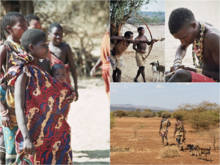








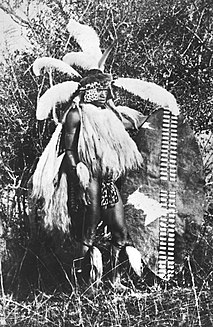



African Great Lakes
[edit]This section needs additional citations for verification. (February 2022) |
- Abagusii: Kenya[16][17]
- Hadza (Hadzabe): Tanzania, Singida region: southeast, south and northwest of Lake Eyashi.[citation needed]
- Iraqw: Tanzania[18][19]
- Kalenjin: Kenya[20][21]
- Kikuyu: Kenya[22][23]
- Luhya: Kenya[24][25]
- Maasai: Kenya, Tanzania[26][27][28]
- Rendille: Kenya[29][30]
- Samburu: Kenya, Tanzania[20][31]
- Sandawe: Tanzania, Dodoma region: Kondoa district, between Bubu and Mponde rivers, Singida region.[citation needed]
- Pygmy peoples:
- Twa[citation needed]
- Bangweulu Twa: Northern Zambia, Bangweulu Swamps,[citation needed]
- Great Lakes Twa: Rwanda, Burundi, Uganda, Democratic Republic of Congo[citation needed]
- Kafwe Twa: Southern Zambia, Kafue Flats[citation needed]
- Lukanga Twa: Central Zambia, Lukanga Swamp[citation needed]
- Nsua: Western Uganda[citation needed]
- Twa[citation needed]
Central Africa
[edit]- Pygmy peoples:
- Bedzan: Northern Central Cameroon
- Mbenga:
- Aka (Bayaka)
- Baka (Bebayaka): Cameroon, Congo (Brazzaville), Gabon, and Central African Republic
- Bongo (Babongo):
- Gyele (Bagyele):
- Kola (Bakola):
- Mbuti (Bambuti):
- Twa
- Angola Twa: Northeastern, Eastern and Southern Angola
- Kasai Twa (Kuba Twa): Central Democratic Republic of Congo
- Mbote Twa: Southeastern Democratic Republic of Congo, Northwest of Lake Tanganyika
- Mongo Twa (Ntomba Twa): Western Democratic Republic of Congo, Lake Tumba, Lake Mai-Ndombe
- Upemba Twa (Luba Twa): Southeastern Democratic Republic of Congo, Upemba Depression
Horn of Africa
[edit]- Afar people (Qafár/'Afár): the Afar Triangle of Djibouti, Eritrea, Ethiopia[32][33]
- Amhara: Ethiopia[34][35][36][37]
- Banna: Southwestern Ethiopia, Southern Nations, Nationalities, and Peoples Region (SNNPR)[38][39]
- Basketo: Southwestern Ethiopia, Southern Nations, Nationalities, and Peoples Region (SNNPR)[40]
- Berta (Funj): Western Ethiopia, Benishangul-Gumuz Region, Far Eastern Sudan[41][42]
- Burji: Southern Ethiopia, Southern Nations, Nationalities, and Peoples Region (SNNPR)[43][44]
- Gedeo: Southern Ethiopia, Southern Nations, Nationalities, and Peoples Region (SNNPR)[44][45]
- Gumuz: Western Ethiopia, Benishangul-Gumuz Region, Far Eastern Sudan[46][47]
- Hamer: Southwestern Ethiopia, Southern Nations, Nationalities, and Peoples Region (SNNPR)[48][49]
- Karo: Southwestern Ethiopia, Southern Nations, Nationalities, and Peoples Region (SNNPR)[50][51]
- Kunama: Western Eritrea, Gash-Barka Region, Far Eastern Sudan[52][53]
- Maale: Southwestern Ethiopia, Southern Nations, Nationalities, and Peoples Region (SNNPR)[38][54]
- Mursi (Mun): mainly in Debub Omo Zone, Southern Nations, Nationalities and Peoples Region, Southwest Ethiopia[55][48]
- Nara: Western Eritrea, Gash-Barka Region, Far Eastern Sudan[53][52]
- Oromo people: Ethiopia, Kenya[51]
- Saho: Central Eritrea, Southern part of Northern Red Sea Region[56][57]
- Shinasha (Shinasha): Northwestern Ethiopia[58]
- Sidama: Southern Ethiopia, Southern Nations, Nationalities, and Peoples Region (SNNPR)[59][60]
- Somalis: Somalia, Djibouti, eastern Ethiopia, northeastern Kenya[61][62]
- Suri Baale: Ethiopia[63]
- Suri Chai: Ethiopia[64][48]
- Suri Timaga: Ethiopia[64]
- Wolayta: Southwestern Ethiopia, Southern Nations, Nationalities, and Peoples Region (SNNPR)[65][66]
- Yem: Southwestern Ethiopia, Southern Nations, Nationalities, and Peoples Region (SNNPR)[50][67]
Sudan
[edit]- Nuba peoples: Sudan, Nuba Hills
- Nubians: Far Northern North Sudan and Far Southern Egypt, along middle Nile river valley banks
- Dinka (Jieng): mainly in Lakes, Warrap and Unity States, Upper Nile river course, Central and North South Sudan.
- Nuer (Naadh): mainly in Jonglei State, East of Upper Nile river course, East Central South Sudan.
- Anuak (Anywaa): mainly East Jonglei State, East South Sudan, and also mainly in Gambela Region, Lowlands of Far Southwest Ethiopia (border areas between South Sudan and Ethiopia).
- Shilluk (Chollo/Cøllø): mainly in North South Sudan, west of the Upper Nile river course, Upper Nile State, South Sudan (Kodok or Kothok, formerly known as Fashoda is in their territory).
- Fur (Fòòrà): Darfur, Western Sudan
- Masalit: Darfur, Western Sudan
- Kadu peoples: Sudan, Nuba Hills
Southern Africa
[edit]- Bantu languages-speaking peoples of Southern Africa: South Africa, Lesotho, Eswatini, Botswana, Mozambique, Zimbabwe, Namibia, southern Angola.
- Nguni people
- Xhosa
- Zulu
- Ndebele
- Northern Ndebele people (Zimbabwe)
- Southern Ndebele people (South Africa)
- Swati
- Phuthi
- Lala
- Bhaca
- Hlubi
- Nhlangwini
- Sotho–Tswana people
- Makua people
- Tswa–Ronga languages people
- Venda people
- Shona people
- Chopi people
- Chewa people
- Yeyi people
- Kavango languages-speaking peoples
- Nguni people
- Southern Khoikhoi languages-speaking peoples: Angola, Namibia, Botswana, Kalahari Desert, Zimbabwe, west and southwestern South Africa.
- Southern San languages-speaking peoples: Angola, Namibia, Botswana, Kalahari Desert, west and southwestern South Africa.
- Kx'a/Ju–ǂHoan
- ǃKung/Juu
- ǂʼAmkoe
- ǂKxʼao-ǁʼae (Auen)
- ǃKung/Juu
- Tuu
- ǃKwi (!Ui)
- ǀXam
- ǂKhomani (Nǀu)
- Khwe (Khoi, Kxoe)
- Taa
- ǃXooŋake/Nǀumde
- Kx'a/Ju–ǂHoan
West Africa
[edit]

- Dogon people: Mali, and small population in Burkina Faso.[68][69]
- Jola people: Guinea-Bissau, The Gambia, and Senegal[70]
- Serer people: Senegal, The Gambia, Guinea-Bissau, Mauritania, and formally North Africa. [71][72]
- Mandinka people: Guinea, Mali, Senegal, The Gambia, Guinea Bissau, Ghana, Liberia, and Sierra Leone.
- Soninke people: Mali, Senegal, and The Gambia.
- Wolof people: Senegal, The Gambia, and Mauritania.
- Mossi people: Burkina Faso, Côte d'Ivoire, and Ghana.
- Hausa people: Nigeria, Niger, Cameroon, Côte d'Ivoire, Ghana, Benin, and Togo.
- Yoruba people: Nigeria, Benin, Ghana, Togo, Côte d'Ivoire, Niger, Sierra Leone, and The Gambia.
- Fula people: Nigeria, Senegal, Sierra Leone, Guinea, Mali, Burkina Faso, Niger, Benin, Mauritania, Guinea Bissau, The Gambia, Togo, Ghana, and Côte d'Ivoire.
- Igbo people: Nigeria, Ghana, The Gambia.
North Africa
[edit]

- Afroasiatic languages
- Berbers (Imazighen): Morocco, Tunisia, Algeria, Libya, Egypt, Mauritania, Mediterranean Coast, Atlas Mountains (Idurar n Waṭlas), North and Western Sahara
- Eastern Berbers
- Nafusa people: Nafusa Mountains (Drar n infusen), Tripolitania, northwestern Libya
- Zuwara Berbers: Zuwara, coast of western Tripolitania in northwestern Libya.
- Matmata Berbers: Matmâta, southern Tunisia
- Djerba Berbers: Djerba Island, southern Tunisia coast
- Sokna Berbers: Sokna Oasis (Isuknan), Fezzan, north central Libya, Sahara
- Awjila: Awjila oasis, Cyrenaica, eastern Libya, Sahara
- Ghadamès: Ghadamès Oasis, western Libya, Sahara
- Siwis: Siwa Oasis (Isiwan), western Egypt, Sahara
- Northern Berbers
- Kabyles (Iqvayliyen): Kabylie (Tamurt n Iqvayliyen), Mediterranean coast of northern Algeria
- Zenati (Iznaten/Iznasen) speakers: regions in Algeria and Morocco
- Mozabites (At Mzab): Mzab region, northern Sahara, north central Algeria
- Shawiya (Išawiyen): Aurès Mountains (Idurar n Awras), northeastern Algeria
- Shenwa (Ichenwiyen): west-central mountains of northwestern Algeria
- Riffians (Irifiyen): Rif, Rif Mountains (Arrif), northern Morocco
- Sanhaja (Iẓnagen/Iẓnajen) peoples: regions in Middle West Atlas Mountains and Eastern Morocco
- Masmuda peoples: regions in Northern and Western Morocco
- Ghomara: Far West Rif Mountains (Arrif), Northern Morocco
- Shilha (Shlḥi): West Atlas Mountains, Western Morocco
- Eastern Berbers
- Berbers (Imazighen): Morocco, Tunisia, Algeria, Libya, Egypt, Mauritania, Mediterranean Coast, Atlas Mountains (Idurar n Waṭlas), North and Western Sahara
- Haratin: Indigenous population of the Maghreb and Sahara of uncertain origin; members now speak either Berber languages or Arabic; inhabit Morocco, Mauritania, Western Sahara, Algeria.
- Serer - current habit Senega, Gambia, Guinea-Bissau and Mauritania[71][72]
- Toubou: Chad
- Copts (Rem en Khēmi/Rem en Kēme): Egypt, the majority of Egypt's population descended from Ancient Egyptians
- Beja: Northeastern Sudan, between Red Sea coast and almost to the Nile River (White Nile and Blue Nile) eastern banks, Far Northwest Eritrea, Sahara Eastern Desert, Far Southeast Egypt
- Guanches: Canary Islands, Spain
West and Central Asia
[edit]West Asia
[edit]



- Afroasiatic languages
- Semitic peoples
- Central Semitic peoples
- Assyrians (Āṯūrāyē/Sūrāyē/Sūryāyē): A Christian Neo-Aramaic-speaking people indigenous to Assyria, which is located in what is now northern Iraq, southeastern Turkey, northeastern Syria and northwestern Iran in Upper Mesopotamia. There is a testified historical continuity between ancient Assyrians and modern Assyrians, for the majority of Assyrians in the same land that they have lived in since antiquity: (Assyria, Athura, Roman Assyria, & Asoristan), before the Arabization of Upper Mesopotamia, that corresponds with old Assyria (originally speakers of the Akkadian language but in antiquity, by the end of the 1st millennium BC, Assyrians adopted the Aramaic language from Aramaeans as an official language of the Assyrian Empire and in present times speak Assyrian Neo-Aramaic. However, not all Assyrians identify as Assyrian, and several are from peoples that adopted an Assyrian ethnic identity .[73]
- West Semitic peoples
- South Semitic peoples
- Bathari people: Dhofar, Southern Oman. Descendants from the original people of Dhofar before Arabization.[citation needed]
- Harasis: Jiddat al-Harasis, Central Oman. Descendants from the original people of South Arabia before Arabization.[citation needed]
- Hobyót people: Dhofar, Southern Oman, Far Eastern Yemen. Descendants from the original people of Dhofar before Arabization.[citation needed]
- Mehris: Al Mahrah, Eastern Yemen, Dhofar, Southern Oman. Descendants from the original people of Dhofar before Arabization.[citation needed]
- Shehri people/Jibbali people: Dhofar, Southern Oman. Descendants from the original people of Dhofar before Arabization.[citation needed]
- Soqotri people: Soqotra island and group of islands, southeast of mainland Yemen, Indian Ocean. Descendants from the original natives of South Arabia before Arabization.[citation needed]
- South Semitic peoples
- Central Semitic peoples
- Semitic peoples
- Bedouin (Badawī) of the interior deserts of Arabia and Syria.[citation needed]
- Druze (Al-Muwaḥḥidūn/Al-Muwaḥḥidīn/Ahl al-Tawḥīd): of Jabal al-Druze, Syria, Lebanon, Jordan and Israel. The faith of the Druze is a blend of Islam's Ismailism, Judaism, Christianity, Neoplatonism, Pythagoreanism, Gnosticism and Greek philosophy.[citation needed] The foundational text of the faith is the Epistles of Wisdom. Even though they have been a minority for their entire history, they have played a significant role in shaping the history of the Levant. Although the faith originally developed out of Ismaili Islam, Druze are usually not considered Muslims. The oldest and most densely-populated Druze communities exist in Mount Lebanon and in the south of Syria around Jabal al-Druze (literally the "Mountain of the Druze").[citation needed]
- Mandaeans[citation needed]
- Marsh Dwellers/Marsh Arabs (Ma'dan/ʻArab al-Ahwār): An Arabic-speaking people living in the marshes of southern Iraq or on the Iranian side of the Shatt al-Arab.[74]
- Northwest Semitic peoples
- Arameans (Āramayē): Central and Western Syria, ancient land of the Aramaeans (Aram) in the Levant, an Aramaic-speaking people that descends from ancient Aramaeans.[citation needed] In recent years, there has been an attempt to revive Western Aramaic among Aramean Christians living in the Israeli village of Jish.[citation needed]
- Canaanite peoples[citation needed]
- Jews:[75] along with Samaritans, descend from the Israelite nation of the southern Levant, who are believed by archaeologists and historians to have branched out of the Canaanite peoples and culture through the development of a distinct monolatrous—and later monotheistic—religion centered on El/Yahweh,[76][77][78] one of the Ancient Canaanite deities. A Jewish diaspora existed for several centuries before the fall of the Second Temple, and their dwelling in other countries for the most part was not a result of compulsory dislocation.[79] Following the Roman Siege of Jerusalem, destruction of Herod's Temple, and failed Jewish revolts, some Jews were either expelled, taken as slaves to Rome, or massacred,[80] while other Jews continued to live in the region over the centuries, despite the conversion of many Jews to Christianity and Islam as well as persecution by the various conquerors of the region, including the Romans, Arabs, Ottomans, and the British. Additionally, a substantial number of diaspora Jews immigrated to Palestine during the 19th and 20th centuries (mainly under the Zionist movement), as well as after the modern State of Israel was established in 1948. This was coupled with the revival of Hebrew, the only Canaanite language still spoken today. DNA studies show that many major diaspora Jewish communities derive a substantial portion of their ancestry from ancient Israelites.[81][82][83][84]
- There are competing claims that Palestinian Arabs and Jews are indigenous to historic Palestine/the Land of Israel.[85][86][87] The argument entered the Israeli–Palestinian conflict in the 1990s, with Palestinians claiming Indigenous status as a pre-existing population displaced by Jewish settlement, and currently constituting a minority in the State of Israel.[88] Israeli Jews have in turn claimed indigeneity based on historic ties to the region and disputed the authenticity of Palestinian claims.[89][90] In 2007, the Negev Bedouin were officially "recognized as an indigenous people of Israel" by the United Nations.[91] This has been criticized both by scholars associated with the Israeli state, who dispute the Bedouin's claim to indigeneity,[92] and those who argue that recognising just one group of Palestinians as Indigenous risks undermining others' claims and "fetishising" nomadic cultures.[93]
- Samaritans (Samerim): of Samaria. An ethno-religious group of the Levant, closely related genetically and culturally to the Jewish diaspora and are understood to have branched off from the latter around the time of the Assyrian exile. The Samaritans are adherents of Samaritanism, an Abrahamic religion closely related to Judaism. Their sole norm of religious observance is the Samaritan Pentateuch.[94][95]
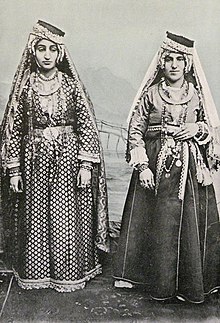
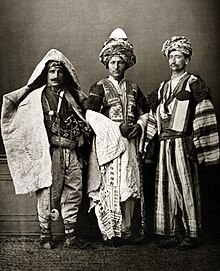


- Iranian peoples
- East Iranian peoples
- Northeast Iranian peoples
- Ossetians (Iræттæ): South Ossetia, Georgia, Southern Caucasus Mountains[citation needed]
- Northeast Iranian peoples
- West Iranian peoples
- Caspian/South Caspian peoples
- Gilaks: Gilan, North Iran, South Caspian Sea coast and Elburz Mountains[citation needed]
- Mazanderanis/Mazanis/Tabaris: Mazanderan, Tabaristan, Northern Iran, South Caspian Sea coast and Elburz Mountains[citation needed]
- Northwest Iranian peoples
- Northwestern I
- Kurds (Kurd/Kurmandzh): Kurdistan, Northwestern and Western Iran, Northern Iraq, Northeast and Northern Syria, Southeast Turkey, Zagros and East Anatolian Plateau[citation needed]
- Yazidis (Êzidî): Nineveh Governorate, Northern Iraq[citation needed]
- Lak people (Iran): Southwestern Iran, Zagros Mountains[citation needed]
- Zaza-Gorani peoples
- Shabaks: Sinjar District of the Nineveh Governorate in northern Iraq.[citation needed]
- Zazas: Southeastern Turkey, Upper Euphrates river, East Anatolian Plateau[citation needed]
- Kurds (Kurd/Kurmandzh): Kurdistan, Northwestern and Western Iran, Northern Iraq, Northeast and Northern Syria, Southeast Turkey, Zagros and East Anatolian Plateau[citation needed]
- Northwestern II
- Baluchis (Baloch/Baluch): Baluchistan, Southeastern Iran, Southwestern Pakistan, Extreme Southern Afghanistan[citation needed]
- Tatic peoples
- Talysh (Talyshon): Talish region (Northwestern Iran, South Azerbaijan, South Caspian Sea coast and Elburz Mountains)[96]
- Tats (Iran)/South Tats (Irünə Tâtün): Northwest Iran[citation needed]
- Northwestern I
- Southwest Iranian peoples
- Persian: Iran, Afghanistan, Tajikistan, Uzbekistan
- Larestani–Gulf peoples
- Kumzaris: Northern Musandam, Oman[citation needed]
- Lurs and Bakhtiaris
- Lurs (Lur): Luristan, Western and Southwestern Iran, Zagros Mountains[citation needed]
- Bakhtiaris (Bakhtiar): Southwestern Iran, Zagros[citation needed]
- Tats (Caucasus): Republic of Azerbaijan, Dagestan (Russia)[citation needed]
- Caspian/South Caspian peoples
- East Iranian peoples
- Iranian peoples
Caucasus
[edit]
- Indo-European peoples
- Armenians (Hayer)
- Iranian peoples
- East Iranian peoples
- Northeast Iranian peoples
- Ossetians (Iræттæ): Ossetia (Iryston), North Ossetia (Cægat Iryston), a Republic of Russia, and South Ossetia (Khussar Iryston), a De Jure autonomous region of Georgia (Sakartvelo), self-proclaimed sovereign country, North and South slopes of Central Caucasus Mountains.
- Northeast Iranian peoples
- West Iranian peoples
- Southwest Iranian peoples
- Persian peoples
- Tats (Caucasus) (Tati/Parsi/Lohijon/Daghli): East Caucasus Mountains, Azerbaijan
- Persian peoples
- Southwest Iranian peoples
- East Iranian peoples
- Kartvelian peoples
- Northeast Caucasian peoples
- Avar-Andic peoples
- Dargins (Darganti): Dagestan, European Russia, Northern Caucasus Mountains
- Khinalug (Kettiturdur/Kayttiodur/Ketid/Ketsh Khalkh)
- Lak people (Dagestan): Dagestan, European Russia, Northern Caucasus Mountains
- Lezgic peoples
- Aghul (Agular): Dagestan, European Russia, Northern Caucasus Mountains
- Archins (Arshishttib)
- Budukh (Budad)
- Jeks (Cekad/Dzhekad)
- Kryts (Kh'rytsha'/Kyrtuar)
- Lezgians (Lezgiyar/Leqer): Dagestan, European Russia, Northern Caucasus Mountains
- Rutul (Mykhabyr): Dagestan, European Russia, Northern Caucasus Mountains
- Tabasarans: Dagestan, European Russia, Northern Caucasus Mountains
- Tsakhur (Yiqby): Azerbaijan, Southern Caucasus Mountains
- Udins (Udi/Uti): Northern Azerbaijan, Southern Caucasus Mountains
- Nakh peoples
- Bats (Batsbi)
- Vainakh peoples
- Chechens (Nokhchiy): Chechnya, European Russia, Northern Caucasus Mountains
- Ingush (Ghalghay): Ingushetia, European Russia, Northern Caucasus Mountains
- Tsezic (Didoic) peoples
- Northwest Caucasian peoples
- Abkhaz-Abaza peoples
- Abazins (Abaza)
- Abkhazians (Aphsua): Abkhazia (Aphsny) - a De Jure autonomous region of Georgia (Sakartvelo), self-proclaimed sovereign country.
- Circassian peoples
- West Circassian peoples
- Adyghe (Adyge): Adyghe Republic, European Russia, Northern Caucasus Mountains
- East Circassian peoples
- Cherkess (Cherkes): Karachay-Cherkessia, European Russia, Northern Caucasus Mountains
- Kabardians (Qeberdeykher): Kabardino-Balkaria, European Russia, Northern Caucasus Mountains
- West Circassian peoples
- Karachays (Karachai): Karachay-Cherkessia, North Caucasian peoples, Northern Caucasus Mountains[97]
- Ubykh (Tʷaχ): were indigenous to the mountains of West Caucasus, Sochi area, Krasnodar Krai, Russia, later migrated to Turkey.
- Abkhaz-Abaza peoples
Central Asia
[edit]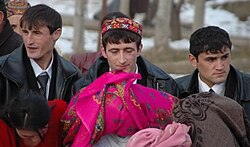
- Indo-European peoples
- Iranian peoples
- East Iranian peoples
- Northeast Iranian peoples
- Pamiris (Pomir): Badakhshan (Afghanistan, Tajikistan), Pamir Mountains, Tashkurgan (in Xinjiang)
- Tajiks: Tajikistan
- Yaghnobi (Yaγnōbī́t): Tajikistan
- Northeast Iranian peoples
- East Iranian peoples
- Turkic peoples
- Kipchak Turks (Northwestern Common Turkic peoples)
- Iranian peoples
South Asia
[edit]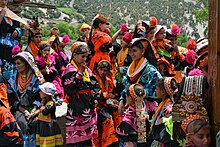



Indian subcontinent
[edit]- Adivasis: collective term for many Indigenous peoples in India
- Dravidian peoples
- Badaga: Tamil Nadu, South India
- Gond: Gondwana Land, Central India
- Irula: Tamil Nadu, South India
- Kisan: Indigenous peoples of the Odisha, East India
- Kodava: Kodagu, Karnataka, South India
- Kota (Kothar/Kov): Tamil Nadu, South India
- Kuruba: Andhra Pradesh, Karnataka, Tamil Nadu, South India
- Tamil: Tamil Nadu, South India and Sri Lanka
- Toda: Tamil Nadu, South India
- South Dravidian peoples
- Indo-European peoples
- Banjara: Rajasthan
- Bhil people: Gujarat, Rajasthan, Madhya Pradesh
- Assamese people[98][99]

Indigenous Tharu woman from Southern Nepal - Warli
- Sino-Tibetan-speaking peoples
- Bodish peoples
- Konyak peoples
- Nocte: Tirap, Arunachal Pradesh, North-East India
- Kukish peoples
- Karbi: Karbi Anglong, Assam, North-East-India
- Mizo (Mizo hnam): Mizoram, North-East India
- Naga: Nagaland, North-East India
- Raji-Raute peoples
- Tripuri (Borok): Tripura, North-East India
- Digaro peoples
- Jumma people (a collective term for several peoples)
- Indigenous peoples of Sikkim: India
- Dravidian peoples
- Burusho: Hunza and Chitral districts, Gilgit-Baltistan, Northern Pakistan
- Sino-Tibetan-speaking peoples
- Lolo-Burmese peoples
- Burmish peoples
- Meitei people: Manipur and neighboring states of India, Bangladesh, Myanmar
- Lolo-Burmese peoples
- Vedda (Wanniyala-Aetto): Sri Lanka
- Dhivehi: Maldives
Andaman and Nicobar Islands
[edit]- Negrito:
- Andamanese, in the Andaman Islands, which include:
- Great Andamanese: formerly at least 10 distinct groups living throughout Great Andaman, now confined to a single community on Strait Island, Andaman Is.
- Jangil (Rutland Jarawa): now extinct, formerly of Rutland Island, Andamans
- Jarawa: South Andaman and Middle Andaman
- Onge (Önge): Little Andaman, Andaman Islands
- Sentinelese (?): North Sentinel Island, Andaman Islands
- Andamanese, in the Andaman Islands, which include:
- Austroasiatic peoples
- Nicobarese people (Holchu): Nicobar Islands, India
- Shompen people (Kalay-Keyet): Nicobar Islands, India
Northeast Asia
[edit]

China
[edit]Western China
[edit]- Turkic peoples
- Common Turks
- Karluks (Southeastern Common Turkic peoples)
- Uyghurs (Uyghur): Tarim Basin, Southern Xinjiang, China
- Ili Turks: Ili Kazakh Autonomous Prefecture, Northern Xinjiang, China
- Äynus: Taklamakan Desert, Southwestern Xinjiang, China
- Yugur (Yogïr/Sarïg Yogïr): Sunan Yugur Autonomous County, Gansu province, China
- Salar (Salır): Xunhua Salar Autonomous County, Qinghai province, China
- Kipchaks (Northwestern Common Turkic peoples)
- Karluks (Southeastern Common Turkic peoples)
- Common Turks
- Tibetan peoples
- Mongolic peoples
North China
[edit]- Fuyu Kyrgyz: Fuyu County, Heilongjiang
- Hui peoples
- Tungusic peoples
- Northern Tungusic peoples
- Nanai (Hezhen/Nanai/Hezhe/Golds/Samagir): Heilongjiang in China, Khabarovsk Krai and Primorsky Krai in Russia
- Oroqen: Far Northern China
- Southern Tungusic peoples
- Northern Tungusic peoples
South China
[edit]- Hmong-Mien peoples
Mongolia
[edit]- Mongolic peoples
- Turkic peoples
- Common Turks
- Karluks (Southeastern Common Turkic peoples)
- Common Turks
Taiwan
[edit]


- Indigenous peoples of the island of Taiwan
- Amis (Pangcah)
- Arikun
- Atayals (Tayal; Tayan)
- Babuza
- Basay
- Bunun
- Hla'alua (Saaroa)
- Kanakanavu
- Kavalan (Kebalan; Kbaran)
- Ketagalan
- Lloa
- Makatao
- Paiwan (Payuan)
- Papora
- Pazeh
- Puyuma (Pinuyumayan)
- Rukai (Drekay)
- Saisiyat (Say-Siyat)
- Sakizaya
- Seediq
- Siraya
- Taivoans
- Tao (Yami)
- Taokas
- Taroko (Truku)
- Thao (Ngan)
- Tsou (Cou)
Japan
[edit]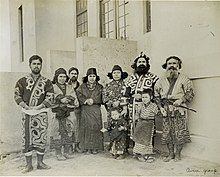
- Ainu (Aynu): Hokkaido, Japan and Sakhalin and the Kuril Islands, Russia
- Ōbeikei Islanders: Bonin Islands, Japan
- Ryukyuans (Ruuchuu Minzuku): Old Ryūkyū Kingdom, now Japan
Korea
[edit]Siberia
[edit]



Over 40 distinct peoples, each with their own language and culture in the Asiatic part of Russia (Siberia/North Asia).
- Chukchi-Kamchatkan peoples
- Chukotkan peoples
- Chukchi (Lyg'oravetl'et/Chukchi people|O'ravetl'et/Ankalyn-Chavchu): Northeast Siberia, Russia
- Koryaks (Nymylan-Chauchuven): Russian Far East
- Alyutors: Russian Far East
- Kereks: Russian Far East
- Kamchatkan peoples
- Chukotkan peoples
- Eskimo-Aleut peoples
- Yupik: Alaska and the Russian Far East
- Siberian Yupik (Yupighyt): Siberia, Russia, Alaska, United States.
- Yupik: Alaska and the Russian Far East
- Mongolic peoples
- Buryats (Buryaad): Buryatia, Russia, and Mongolia
- Hamnigans: Zabaykalsky Krai, Russia, Mongolia, and China
- Tungusic peoples
- Turkic peoples
- Siberian Turks
- Altaians (Altay-kizhi): titular nation of Altai Republic, Russia
- Chulyms: Tomsk Oblast, Russia
- Dolgans: Northern Siberia
- Khakas (Tadarlar): titular nation of Khakassia, Russia
- Kumandins: Altai Krai, Russia
- Shors: Southern Siberia
- Soyots: Buryatia, Russia
- Teleuts: Kemerovo Oblast, Russia
- Tofalars: Southern Siberia
- Tuvans (Tyvalar): titular nation of Tuva Republic, Russia
- Tozhu Tuvans: Tuva Republic, Russia
- Yakuts (Sakha): titular nation of Yakutia, Russia
- Kipchak Turks
- Siberian Turks
- Ugric peoples
- Ugrians: Yugra, Western Siberia, Russia
- Khanty (Hantõ-Kantõk/Kantek/Khanti): Yugra, Western Siberia, Russia
- Mansi (Maan's'i/Maan's'i Maahum/Mansi), formerly known as Voguls: Yugra, Western Siberia, Russia
- Ugrians: Yugra, Western Siberia, Russia
- Samoyedic peoples
- Northern Samoyedic peoples: West Siberia and Far Northern European Russia
- Enets (Entsi): Far Northern Western Siberia, Russia
- Nenets (Neney Neneche): Far Northern Western Siberia and Far Northern European Russia
- Nganasan (Ŋənəhsa(nəh)): Taymyr Peninsula, Siberia, Russia
- Northern Samoyedic peoples: West Siberia and Far Northern European Russia
- Yukaghirs (Odul/Vadul/Detkil'): Far Northern East Siberia, Russia
- Yeniseian peoples
- Ket (Deng): Along middle Yenisei river banks
- Nivkh (Gilyak): Sakhalin, Russia
- Oroks (Uilta): Sakhalin, Russia
Southeast Asia
[edit]
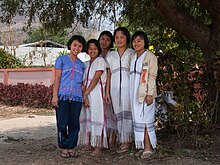

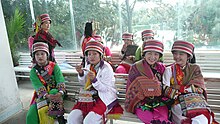

- Austroasiatic peoples
- Aslian peoples
- Senoi (Sengoi/Sng'oi) (a people of the ethnic groups called by the generic word Orang Asli - Original People): in Peninsular Malaysia)[100]
- Khmer Krom: of Vietnam
- Khmuic groups:
- Palaungic peoples
- Wa (Vāx): One of the hill tribes of Myanmar (They are also distributed in Yunnan Province, China in East Asia).
- Zomi (Zo Pau): One of the Indigenous peoples in Southeast Asia. The word Zomi is the collective name given to many tribes who traced their descent from a common ancestor. Through history they have been known under various appellation, such as Chin, Kuki and Mizo, but the expression was disliked by them, and they insist that the term was a misnomer given by others and by which they have been recorded in certain documents designate their ancient origins as a separate ethnicity.
- Vietic peoples
- Aslian peoples
- Austronesian peoples
- Malayo-Polynesian peoples
- Chamic peoples
- Proto-Malay (a people of the ethnic groups called by the generic word Orang Asli - Original People): in Peninsular Malaysia
- Moken: in Myanmar, and Thailand
- Malayo-Polynesian peoples
- Hmong-Mien peoples
- Montagnards (Degar): an umbrella term for several Pre-Vietnamese peoples that dwell in the plateaus and mountains of the southern regions of Vietnam
- Austroasiatic peoples
- Bahnaric peoples
- North Bahnaric peoples
- Sedang, Halang and Kayong: Vietnam
- H're people: Quảng Ngãi Province, Central Vietnam
- Central Bahnaric peoples
- Bahnar: Central Highland provinces of Gia Lai and Kon Tum, as well as the coastal provinces of Bình Định and Phú Yên (Vietnam)
- Jeh-Tariang people: Kon Tum, Vietnam
- Southern Bahnaric peoples
- Eastern Bahnaric:
- North Bahnaric peoples
- Katuic peoples
- Bahnaric peoples
- Austronesian peoples
- Malayo-Polynesian peoples
- Chamic peoples
- Highlands Chamic peoples
- Rade-Jarai
- Jarai: Central Highlands of Vietnam, as well as in the Northeast Province of Ratanakiri (Cambodia)
- Rhade: Southern Vietnam
- Chru–Northern
- Northern Cham
- Raglai: in Khánh Hòa Province of South Central Coast, and Ninh Thuận Province in the Southeast region of Vietnam
- Northern Cham
- Rade-Jarai
- Highlands Chamic peoples
- Chamic peoples
- Malayo-Polynesian peoples
- Austroasiatic peoples
- Negrito:
- Mani (Maniq): Far Southern Thailand
- Semang (a group of several peoples of the ethnic groups called by the generic word Orang Asli - Original People): Peninsular Malaysia
- Batek: Peninsular Malaysia
- Sino-Tibetan-speaking peoples
- Karenic peoples
- Karen (Per Ploan Poe/Ploan/Pwa Ka Nyaw/Kanyaw): an alliance of hill tribes of Myanmar and Thailand
- Lolo-Burmese peoples
- Akha a.k.a. Aini or Aini-Akha: One of the hill tribes of Thailand, Laos and Burma (They are also distributed in Yunnan Province, China in East Asia).
- Lahu (Ladhulsi/Kawzhawd): One of the hill tribes of Thailand, Myanmar and Laos (They are also distributed in Yunnan, China).
- Lisu: One of the hill tribes of Myanmar and Thailand (They are also distributed in Arunachal Pradesh, India in South Asia and Yunnan and Sichuan, China).
- Rakhine (Rəkhàin lùmjó), Kaman and Marma: Arakan in Myanmar
- Yi (Nuosu/Nisu/Sani/Axi/Lolo): a group of several related peoples mainly in Yunnan, China.
- Tibeto-Burman peoples
- Karenic peoples
- Tai peoples: Vietnam, Myanmar, Laos and Thailand (They are also distributed in Yunnan, China).
- Southwestern Tai peoples


- Austronesian peoples
- Malayo-Polynesian peoples
- Barito peoples
- Bajau (Sama/Samah/Samal): Borneo and the Sulu Archipelago (Malaysia, Indonesia, Philippines)
- Dayak: Borneo, (Malaysia and Indonesia)
- Northwest Sumatra–Barrier Islands peoples
- Mentawai peoples
- Malayic peoples
- Orang Laut and Orang Seletar: Malaysia and Singapore
- Proto-Malay (Melayu asli/Melayu purba): Malaysia
- North Bornean peoples
- Philippine peoples
- Igorot (Ifugao: Ipugao; Benguet: Ibaloi, Kankanaey; Mountain Province: Bontoc; Kalinga: Kiangan; Abra: Itneg; Apayao: Isneg):[103] Cordillera mountains in Luzon in the Philippines
- Lumad (Katawhang Lumad): Mindanao in the Philippines
- Mangyan: Mindoro in the Philippines
- Moro: Mindanao and Sulu archipelago in the Philippines
- Tausug (Tausūg/Suluk/Sulug)
- Maguindanao
- Maranao (Iranon/Iranun)
- Tribes of Palawan: Palawan, Philippines
- Barito peoples
- Malayo-Polynesian peoples
- Orang Rimba (Orang Batin Sembilan/Orang Rimba/Anak Dalam/Kubu): Sumatra, Indonesia
- Lubu: Sumatra, Indonesia
- Negrito:
- Pribumi (Native Indonesians): of Indonesia
Europe
[edit]
Some sources describe the Sámi as the only recognized indigenous peoples in Europe,[104][105][106] with others describing them as the only indigenous people in the European Union.[107][108][109][110] Other groups, particularly in Central, Western and Southern Europe, that might be considered to fit the description of indigenous peoples in the Indigenous and Tribal Peoples Convention, 1989, such as the Sorbs, are generally categorized as national minorities instead.[111]
Northern Europe
[edit]Eastern Europe
[edit]- Turkic peoples
- Kipchak Turks (Northwestern Common Turkic peoples)
- Krymchaks (Qrymçaklar): Crimean Peninsula in Southern Ukraine[114]
- Crimean Karaites (Qrymqaraylar): Crimean Peninsula in Southern Ukraine[114]
- Crimean Tatars (Qırımtatarlar): Crimean Peninsula in Southern Ukraine[114]
- Kipchak Turks (Northwestern Common Turkic peoples)
Western Europe
[edit]- Irish Travellers of the island of Ireland[115][116]
Americas
[edit]The Americas consist of the supercontinent comprising North and South America, and associated islands.
List of peoples by geographical and ethnolinguistic grouping:
North America
[edit]North America includes all of the continent and islands east of the Bering Strait and north of the Isthmus of Panama; it includes Greenland, Canada, United States, Mexico, Central American and Caribbean countries. However a distinction can be made between a broader North America and a narrower Northern America and Middle America due to ethnic and cultural characteristics.
- Indigenous peoples in North America by Country
- Indigenous peoples in North America by native cultural regions
Arctic
[edit]
- Ancient Beringian - Siberia and Alaska
- Eskimo–Aleut
- Aleut (Unangax): Aleutian Islands and Kamchatka Krai
- Eskimo/Yupit-Inuit
- Yupik: Alaska, United States
- Alutiiq (Sugpiat): Alaska, United States
- Central Alaskan Yup'ik (Yupiat/Yupiit): Alaska, United States
- Cup'ik (Cupiit): Alaska, United States
- Cup'ig: Nunivak Island, Alaska, United States
- Siberian Yupik of St. Lawrence Island, Alaska, United States.
- Inuit: Canadian Arctic - Northwest Territories, Nunavik, Nunatsiavut, Nunavut; Greenland; Alaska, United States
- Greenlandic Inuit: Greenland
- Inupiat (Iñupiat): Arctic Alaska, North Slope and boroughs and the Bering Strait
- Inuit: Canadian Arctic
- Eastern Canadian Inuit: East Canadian Arctic, East Nunavut, Nunavik, Nunatsiavut
- Western Canadian Inuit (Inuvialuit): West Canadian Arctic, Inuvialuit Settlement Region, Arctic coast of Northwest Territories, West Nunavut
- Yupik: Alaska, United States
- Métis: a mixed First Nations (from several peoples) and European (from several peoples) people of Canada.
Subarctic
[edit]- Na-Dené peoples
- Athabaskan peoples
- Northern Athabaskan peoples
- Dene of Yukon, British Columbia, Manitoba, Northwest Territory, and Alberta, Canada.
- Alaskan Athabaskans
- Southern Alaskan peoples
- Koyukon of Interior Alaska.
- Kutchin of Interior Alaska and the Yukon.
- Tanana Athabaskans.
- Kolchan of Interior Alaska.
- Deg Hit'an of Interior Alaska.
- Dena'ina of Interior Alaska.
- Holikachuk
- Hän of Yukon, Canada, and Alaska, United States.
- Northern Athabaskan peoples
- Athabaskan peoples
- Métis: a mixed Native American (from several peoples) and European (from several peoples) people of Canada.
- Algonquians
- Cree of Montana, United States, and Manitoba, Alberta, and Saskatchewan, Canada.
- Innu of Northeastern Quebec, and Western Labrador, Canada.
- Annishinabe of Quebec, Ontario, and Manitoba, Canada, as well as Kansas, Michigan, Minnesota, Oklahoma, and Wisconsin, United States.
- Beothuk of Newfoundland, Canada.
Pacific Northwest Coast
[edit]- Makah of Washington, United States.
- Quinault of Washington, United States.
- Nootka of British Columbia, Canada.
- Kwakiutl of British Columbia, Canada.
- Eyak of Alaska, United States.
- Haida of British Columbia, Canada, and Alaska, United States.
- Tlingit of Alaska, United States.
- Tshimshian of British Columbia, Canada, and Alaska, United States.
Northwest Plateau-Great Basin-California
[edit]Northwest Plateau
[edit]Great Basin
[edit]- Ute of Utah, United States.
- Shoshone of Colorado, Wyoming, Nevada, and Utah, United States.
- Mono of California, United States.
- Bannock of Idaho, United States.
- Western Shoshone of Nevada, United States.
- Timbisha of Nevada, United States.
- Washoe of Nevada, United States.
- Paiute of Colorado, California, Nevada, and Utah, United States.
- Pais of Colorado, Arizona, and New Mexico, United States, as well as Baja California, Mexico.
- Hualapai of Arizona, United States.
- Walapai of Arizona and Colorado, United States.
California
[edit]- Yuman-Cochimi peoples
- Cochimí people: Baja California, Mexico
- Core Yuman peoples
- Kiliwa (K'olew): Baja California, Mexico
- Paipai (Akwa'ala/Yakakwal): Baja California, Mexico
- Delta-Californian peoples
- Cocopa (Cocopah/Xawiƚƚ Kwñchawaay): Baja California, Mexico, and Arizona, United States.
- Kumeyaay (Ipai-Tipai/MuttTipi): Baja California, Mexico, and California, United States.
- Miwok of California, United States.
- Maidu of California, United States.
- Wintu of California, United States.
- Chumash of California, United States.
- Tongva of California, United States.
- Modoc of California, and Oregon, United States.
- Athabaskans
- Achumawi of California, and Oregon, United States.
- Hupa of California and Oregon, United States.
- Cahuilla of California, United States.
- Mojave of California, and Nevada, United States.
- Uto-Aztecans
- Mono of California, and Nevada, United States.
- Northern Paiute of California and Nevada, United States.
- Ohlone of California, United States.
- Karok of California, United States.
Great Plains
[edit]

- Comanche of Texas and Oklahoma, United States.
- Osage of Kansas and Nebraska, United States.
- Sioux of North Dakota, South Dakota, and Minnesota, United States, as well as Saskatchewan, and Alberta, Canada.
- Lakota of South Dakota, United States.
- Dakota people of Minnesota, United States, and Saskatchewan, Canada.
- Kiowa of Texas, and Oklahoma.
- Plains Apache of Texas, and Oklahoma.
- Crow of Montana.
- Omaha of Nebraska.
- Blackfoot of Montana, United States, Alberta, Canada, and Saskatchewan, Canada.
Eastern Woodlands
[edit]Northeastern Woodlands
[edit]- Iroquoian peoples
- Haudenosaunee of New York, Wisconsin, and Oklahoma, United States, as well as Quebec and Ontario, Canada.
- Mohawk of Quebec, Canada, and New York, United States.
- Seneca of New York, and Oklahoma, United States, as well as Ontario, Canada.
- Cayuga of Oklahoma, and New York, United States, as well as Ontario, Canada.
- Oneida of Wisconsin and New York, United States, as well as Ontario, Canada.
- Tuscarora of New York, United States, and Ontario, Canada.
- Onondaga of New York, United States, and Ontario, Canada.
- Wyandot of Kansas, Michigan, and Oklahoma, United States, as well as Ontario, Canada.
- Nation du chat of Upstate New York, Ohio, and Northwest Pennsylvania, United States.
- Conestoga (Susquehannock) of Pennsylvania, West Virginia, New York, and Maryland (United States).
- St. Lawrence Iroquoians: St. Lawrence River, Quebec, Canada, and New York, United States.
- Monongahela: Pennsylvania, West Virginia, and Ohio, United States.
- Nottoway of Virginia, United States.
- Westo of Virginia and South Carolina, United States.
- Haudenosaunee of New York, Wisconsin, and Oklahoma, United States, as well as Quebec and Ontario, Canada.
- Algic peoples
- Algonquian peoples
- Chowanoke of North Carolina.
- Carolina Algonquian
- Powhatan Confederacy of Virginia.
- Wampanoag of Massachusetts.
- Wabanaki of Maine, United States, and New Brunswick and Newfoundland, Canada.
- Abenaki of New Hampshire, Maine and Vermont.
- Penobscot of Maine.
- Miqmac of Maine, New Brunswick, and Newfoundland.
- Passamaquoddy of Maine, United States, and New Brunswick, Canada.
- Maliseet of New Brunswick and Quebec.
- Shawnee of the Ohio River Valley, now Oklahoma.
- Central Algonquian peoples
- Kikapú (Kiikaapoa/Kiikaapoi): Indigenous peoples from southeast Michigan, United States, also in Coahuila, Mexico.
- Peoria (Illiniwek)
- Annishinabe
- Ojibwe of Minnesota, North Dakota, and Michigan, United States, as well as Ontario, Canada.
- Potawatomi of Michigan and Indiana, United States, as well as Ontario, Canada.
- Odawa of Oklahoma and Michigan, United States, as well as Ontario, Canada.
- Cree of Alberta, Manitoba, Ontario, Saskatchewan, and the Northwest Territories, Canada, as well as Montana, United States.
- Algonquian peoples
Southeastern Woodlands
[edit]- Cherokee of North Carolina, Georgia, and Oklahoma.
- Natchez of Louisiana and Arkansas.
- Muskogeans
- Indigenous peoples of Florida
- Siouans
- Ho-Chunk of Wisconsin and Michigan.
- Catawba of North Carolina.
- Pee Dee of South Carolina.
- Caddoans
- Caddo of Texas, Arkansas, and Louisiana.
- Pawnee of Oklahoma, Nebraska and Kansas, United States.
- Southern Plains villagers of Western Oklahoma, Texas, Kansas, and Southeastern Colorado.
- Arikara of North Dakota, United States.
- Hidatsa of North Dakota, United States.
- Wichita of Oklahoma, Kansas, and Texas, United States.
Southwest
[edit]

- Uto-Aztecan peoples
- Aztecan (Nahuan) peoples
- Mexicanero (Mēxihcah): Durango, Mexico
- Cáhitan peoples
- Tarahumaran peoples
- Tepiman peoples
- Aztecan (Nahuan) peoples
- Seri (Comcaac): Sonora, Mexico
- Puebloan peoples: Colorado, New Mexico, Arizona, Utah, and Texas, United States
- Hopi of New Mexico, United States.
- Zuni of Arizona, United States.
- Anasazi of New Mexico and Colorado, United States.
- Tiwa of New Mexico, United States.
- Mogollon of New Mexico, Arizona, United States, and Sonora, Mexico.
- Hohokam of Southern Arizona, United States.
- Southern Athabascans
- Apache of Chihuahua, Coahuilla, and Sonora, Mexico, as well as Arizona, New Mexico, Oklahoma, and Texas, United States.
- Chiricahua of Southern New Mexico, Northern Mexico, and Southeast Arizona.
- Lipan Apache of Northern Texas, and Western Oklahoma.
- Plains Apache of Oklahoma.
- Mescalero of Arizona, New Mexico, and Northern Chihuahua.
- Western Apache of Western Arizona.
- Navajo of the Four Corners region.
- Apache of Chihuahua, Coahuilla, and Sonora, Mexico, as well as Arizona, New Mexico, Oklahoma, and Texas, United States.
- O'odham of Sonora, Mexico, and Arizona, United States.
- Pima of Arizona, United States.
- Papago of far Northern Sonora, Mexico, and Southern Arizona, United States.
Mesoamerica
[edit]
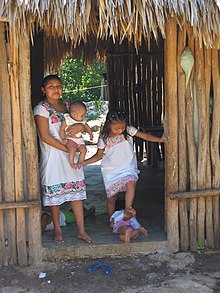


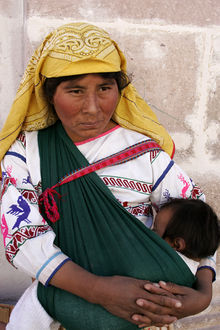
- Huave (Ikoots/Kunajts): Oaxaca, Mexico
- Maya peoples
- Huastec (Téenek/Te' Inik): San Luis Potosí, Mexico
- Mixe-Zoquean peoples
- Oto-Manguean peoples
- Amuzgo (Tzjon Non/Tzo'tyio/Ñ'anncue): Oaxaca, Mexico
- Chinantec: Oaxaca, Mexico
- Mixtecan
- Oto-Pamean peoples
- Chichimeca Jonaz (Úza): San Luis Potosí, Mexico
- Matlatzinca: Mexico (state), Mexico
- Mazahua (Tetjo Ñaa Jñatjo): Mexico (state), Mexico
- Otomi (Hñähñu/Hñähño/Ñuhu/Ñhato/Ñuhmu): Central Mexico
- Pame (Xi'úi): San Luis Potosí, Mexico
- Popolocan peoples
- Tlapanec (Me'phaa): Guerrero, Mexico
- Zapotecan peoples
- Tarascan (P'urhépecha): Michoacán, Mexico
- Tequistlatecan/Chontal de Oaxaca: Oaxaca, Mexico
- Totonacan peoples
- Uto-Aztecan peoples
Central America
[edit]Central America is generally defined as a subregion in North America located between the Isthmus of Tehuantepec and the Darién Gap.
- Indigenous peoples in Central America by country:

Mesoamerica
[edit]- Maya peoples
- Lenca: Honduras and El Salvador
- Mamean peoples
- Q'anjobalan peoples
- Qichean peoples
- Oto-Manguean peoples
- Manguean
- Chorotega (Mangue/Mankeme): Honduras, Nicaragua, and Costa Rica
- Manguean
- Xinca (Xinka): Guatemala
Isthmo-Colombian Area
[edit]

- Chibchan peoples
- Boruca: Costa Rica
- Bribri: Costa Rica
- Cabécar: Costa Rica
- Naso/Teribe/Tjër Di: Costa Rica, Panama
- Guaymi/Waimi peoples
- Bokota: Panama
- Ngäbe–Buglé: Panama, Costa Rica
- Talamanca peoplesl
- Kuna (Dule/Tule): Panama
- Pech: Honduras
- Votic peoples
- Chocó/Embera-Wounaan peoples
- Misumalpan peoples
- Tolupan/Jicaque: Honduras
- Zambo/Cafuso peoples (mixed West African and Amerindian peoples)
- Garífuna: A mixed West African (from several peoples) and Amerindian people (mainly from the Island Caribs - Kalhíphona) that traditionally speaks an Arawakan language in Belize and Honduras.
- Miskito Sambu: A mixed West African (from several peoples) and Amerindian people (mainly from the original Miskito) that traditionally speaks Miskito, a Misumalpan language, and also Nicaragua Creole English in Nicaragua and Honduras.
- Black Seminoles: Florida, The Bahamas, and Mexico. (Mixed Seminole and African).
South America
[edit]
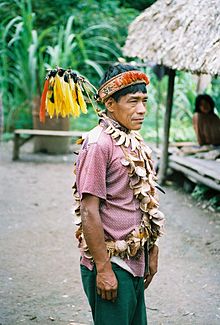
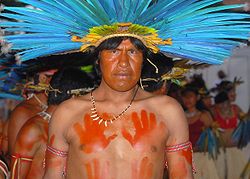

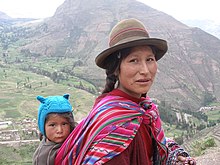
South America generally includes all of the continent and islands south of the Isthmus of Panama.
- Indigenous peoples in South America by country:
- Indigenous peoples in South America by native cultural regions
Isthmo-Colombian Area
[edit]- Arawakan peoples
- Northern
- Chibchan peoples
- Chocoan peoples
- Warao: Venezuela's Orinoco River delta region.
Amazon
[edit]- Arawakan peoples
- Barbacoan peoples
- Awan
- Awá-Kwaiker: Northern Ecuador
- Awan
- Bora-Witoto peoples
- Cahuapanan peoples
- Jivaroan (Shuar): Loreto and San Martín, Peru
- Nukak: Colombia
- Panoan peoples
- Pirahã: Brazil
- Ticuna-Yuri peoples
- Tucanoan peoples
- Tupian peoples
- Urarina (Kachá): Chambira Basin, Loreto Peru
- Yanomami (Yanõmami/Yanõmami Thëpë): Venezuela/Brazil
Guianas
[edit]- Cariban peoples
- Yanomami (Yanõmami/Yanõmami Thëpë): Venezuela/Brazil
- Piaroa (Wothïha): Venezuela/Colombia
Eastern Highlands (Brazilian Highlands)
[edit]- Charruan peoples
- Macro-Gê peoples
- Tupian peoples
- Tupí-Guaraní
Chaco
[edit]Central Andes
[edit]- Atacama people: Chile, Argentina, and Bolivia
- Aymaran peoples
- Diaguita: Chile/Argentina
- Maina people: Peru
- Nasa: Colombia
- Quechuan peoples
- Uru people: Lake Titicaca, Peru and Bolivia
Southern Cone
[edit]Araucania
[edit]- Araucanian peoples
Pampas
[edit]Patagonia
[edit]
- Chono: Chiloé, Guaitecas and Chonos, Chile
- Tehuelche: Southern Chile/Argentina
- Alacalufe (Kawésqar): Tierra del Fuego, Chile
- Selk'nam (Ona): Tierra del Fuego, Argentina and Chile
- Yaghan (Yámana): Tierra del Fuego, Chile
- Haush (Manek'enk): Tierra del Fuego, Argentina
Caribbean
[edit]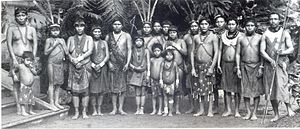
The West Indies, or the Caribbean, generally includes the island chains of the Caribbean Sea, namely the Lucayan Archipelago, the Greater Antilles, and the Lesser Antilles.
- Arawakan peoples
- Northern
- Circum-Caribbean/Ta-Arawakan peoples
- Eyeri/Igneri: Lesser Antilles. An Arawak people, may have been the Kalinago/Island Caribs before caribbeanization. (The Island Caribs had the tradition that the Igneri were the older people of Lesser Antilles but they could have been ancestors of the majority of Island Caribs).
- Island Caribs (Carib/Kalinago/Kalhíphona): Lesser Antilles. Often called "Island Caribs" (but may have been an older arawak people with a carib conquering warrior elite or influenced by Mainland Caribs. Apparently, the majority of the people spoke an arawakan language and not a carib one.)
- Taíno: Amerindians who originally inhabited the Greater Antilles of the Caribbean, they are of Arawakan descent.
- Neo-Taíno nations Some scholars distinguish between the Taíno and Neo-Taíno groups. Neo-Taíno groups were also native to the Antilles islands, but had distinctive languages and cultural practices that differed from the High Taíno.[117] These groups include:
- Circum-Caribbean/Ta-Arawakan peoples
- Northern
- Ciguayo: Eastern Hispaniola
- Macorix: Hispaniola
- Guanahatabey: Western Cuba
Oceania
[edit]Oceania includes most islands of the Pacific Ocean, New Guinea, New Zealand and the continent of Australia.
List of peoples by geographical and ethnolinguistic grouping:
Australia
[edit]


Indigenous Australians include Aboriginal Australians on the mainland and Tiwi Islands as well as Torres Strait Islander peoples from the Torres Strait Islands.
- Aboriginal Australians include hundreds of groupings of people, defined by various overlapping characteristics such as language, culture and geography, which may include sub-groups. The Indigenous peoples of the island state of Tasmania and the Tiwi people (of the Tiwi Islands off the Northern Territory) are also Aboriginal peoples, who are genetically and culturally distinct from Torres Strait Islander peoples.
- Torres Strait Islander peoples are culturally and linguistically Papuo-Austronesian, and the various peoples of the islands are of predominantly Melanesian descent. The Torres Strait Islands are part of the state of Queensland.
Western Desert
[edit]- Pama-Nyungan peoples
- Kunapa: Northern Territory, Australia
- Pini: Western Australia, Australia
- Spinifex: Western Australia, Australia
- Wangkatha: Western Australia, Australia
- Warumungu: Northern Territory, Australia
- Wati peoples
- Antakirinja: South Australia, Australia
- Kokatha: South Australia, Australia
- Luritja: Northern Territory, Australia
- Madoidja: Western Australia, Australia
- Maduwongga: Western Australia, Australia
- Martu peoples
- Marrngu peoples
- Ngaanyatjarra: Northern Territory, Australia
- Ngaatjatjarra: Western Australia, Australia
- Pintupi: Western Australia, Australia
- Pitjantjatjara: Northern Territory, Australia
- Wangkatjunga: Western Australia, Australia
- Yankunytjatjara: South Australia, Australia
- Yulparija: Western Australia, Australia
- Yumu: Northern Territory, Australia
- Yankuntjatjarra: South Australia, Australia
- Mirndi peoples
Kimberley
[edit]- Bunuban peoples
- Jarrakan peoples
- Gija: Halls Creek and Kununurra, Western Australia, Australia
- Miriwoongic peoples
- Nyulnyulan peoples
- Nyulnyulic peoples
- Dyukun peoples
- Worrorran peoples
Northwest
[edit]- Pama-Nyungan peoples
- Ngayarda peoples
- Bailgu: Pilbara region, Western Australia, Australia
- Inawongga: Pilbara region, Western Australia, Australia
- Jadira: Pilbara region, Western Australia, Australia
- Kurrama: Pilbara region, Western Australia, Australia
- Mardudunera: Pilbara region, Western Australia, Australia
- Ngarla: Pilbara region, Western Australia, Australia
- Ngarluma: Pilbara region, Western Australia, Australia
- Niabali: Pilbara region, Western Australia, Australia
- Nhuwala: Pilbara region, Western Australia, Australia
- Nyamal: Pilbara region, Western Australia, Australia
- Panyjima: Pilbara region, Western Australia, Australia
- Tjuroro: Pilbara region, Western Australia, Australia
- Kanyara-Mantharta peoples
- Kanyara peoples
- Baiyungu: Gascoyne region, Western Australia, Australia
- Binigura: Pilbara region, Western Australia, Australia
- Buruna: Mid West region, Western Australia, Australia
- Thalanyji: Pilbara region, Western Australia, Australia
- Yinikutira: Exmouth, Western Australia, Australia
- Mantharta peoples
- Djiwali: Pilbara region, Western Australia, Australia
- Tharrkari: Gascoyne region, Western Australia, Australia
- Tenma: Pilbara region, Western Australia, Australia
- Warriyangga: Gascoyne region, Western Australia, Australia
- Kanyara peoples
- Kartu peoples
- Badimaya: Mid West region, Western Australia, Australia
- Maia: Mid West region, Western Australia, Australia
- Malgana: Mid West region, Western Australia, Australia
- Nanda: Mid West region, Western Australia, Australia
- Nokaan: Mid West region, Western Australia, Australia
- Wajarri: Mid West region, Western Australia, Australia
- Widi: Mid West region, Western Australia, Australia
- Yingkarta: Gascoyne region, Western Australia, Australia
- Ngayarda peoples
Southwest
[edit]- Pama-Nyungan peoples
- Nyungic peoples
- Noongar peoples
- Amangu: Geraldton Sandplains, Western Australia, Australia
- Ballardong: Avon Wheatbelt, Western Australia, Australia
- Yued: Swan Coastal Plain, Western Australia, Australia
- Kaneang: Jarrah Forest, Western Australia, Australia
- Koreng: Mallee, Western Australia, Australia
- Mineng: Warren, Western Australia, Australia
- Njakinjaki: Avon Wheatbelt, Western Australia, Australia
- Njunga: Esperance Plains, Western Australia, Australia
- Bibulman: Warren, Western Australia, Australia
- Pindjarup: Jarrah Forest, Western Australia, Australia
- Wardandi: Swan Coastal Plain, Western Australia, Australia
- Whadjuk: Jarrah Forest, Western Australia, Australia
- Wiilman: Western Australia, Australia
- Wudjari: Mallee, Western Australia, Australia
- Kalaako: Goldfields–Esperance region, Western Australia, Australia
- Kalamaia: Western Australia, Australia
- Mirning peoples
- Yingkarta: Gascoyne region, Western Australia, Australia
- Noongar peoples
- Nyungic peoples
Fitzmaurice Basin
[edit]- Yirram peoples
- Macro-Gunwinyguan peoples
- Kungarakany: Northern Territory, Australia
- Warrayic peoples
- Kungarakany: Northern Territory, Australia
- Daly peoples
- Wagaydic peoples
- Mulluk-Mulluk: Northern Territory, Australia
- Western Daly peoples
- Emmiyangal: Anson Bay, Northern Territory, Australia
- Marranunggu: Daly River, Northern Territory, Australia
- Menthe: Northern Territory, Australia
- Marrithiyal: Daly River, Northern Territory, Australia
- Maramanindji: Northern Territory, Australia
- Marridan: Northern Territory, Australia
- Marri Amu: Northern Territory, Australia
- Marri Tjevin: Northern Territory, Australia
- Marijedi: Northern Territory, Australia
- Marri Ngarr: Moyle River, Northern Territory, Australia
- Mati Ke: Wadeye, Northern Territory, Australia
- Eastern Daly peoples
- Southern Daly peoples
Arnhem Land
[edit]- Pama-Nyungan peoples
- Macro-Gunwinyguan peoples
- Maningrida peoples
- East Arnhem peoples
- Marran peoples
- Gaagudju: Northern Territory, Australia
- Gunwinyguan peoples
- Gunwinggic peoples
- Dalabon: Northern Territory, Australia
- Jawoyn: Nitmiluk National Park, Northern Territory, Australia
- Jala peoples
- Iwaidjan peoples
- Amurdak: Cobourg Peninsula, Northern Territory, Australia
- Iwaidjic peoples
- Marrku-Wurrugu peoples
Top End
[edit]- Tiwi: Tiwi Islands, Northern Territory, Australia
- Darwin Region peoples
- Larrakia: Darwin, Northern Territory, Australia
- Limilngan
- Umbugarlic peoples
- Giimbiyu: Alligator Rivers, Northern Territory, Australia
Gulf Country
[edit]- Pama-Nyungan peoples
- Tankgkic peoples
- Garawan peoples
Cape York
[edit]West Cape
[edit]- Pama-Nyungan peoples
- Paman peoples
- North Cape York Paman peoples
- Djagaraga: Cape York Peninsula, Queensland, Australia
- Tjungundji: Cape York Peninsula, Queensland, Australia
- Injinoo: Cape York Peninsula, Queensland, Australia
- Luthigh: Cape York Peninsula, Queensland, Australia
- Mbewum: Cape York Peninsula, Queensland, Australia
- Tjungundji: Cape York Peninsula, Queensland, Australia
- Totj: Cape York Peninsula, Queensland, Australia
- Unduyamo: Cape York Peninsula, Queensland, Australia
- Wik peoples
- Wik-Mungkan: Cape York Peninsula, Queensland, Australia
- Kugu Nganhcara: Cape York Peninsula, Queensland, Australia
- Wiknatanja: Cape York Peninsula, Queensland, Australia
- Wik Me'anh: Cape York Peninsula, Queensland, Australia
- Wik Epa: Cape York Peninsula, Queensland, Australia
- Wik Elken: Cape York Peninsula, Queensland, Australia
- Wik Paach: Cape York Peninsula, Queensland, Australia
- Wik Ompom: Cape York Peninsula, Queensland, Australia
- Wimaranga: Cape York Peninsula, Queensland, Australia
- Winduwinda: Cape York Peninsula, Queensland, Australia
- Thaypan peoples
- North Cape York Paman peoples
- Paman peoples
East Cape
[edit]- Pama-Nyungan peoples
- Paman peoples
- North Cape York Paman peoples
- Lamalamic peoples
- Northeast Paman peoples
- Paman peoples
Daintree Rainforest
[edit]- Pama-Nyungan peoples
Lake Eyre Basin
[edit]- Pama-Nyungan peoples
- Kalkatungic peoples
- Karnic peoples
- Yarli peoples
Spencer Gulf
[edit]- Pama-Nyungan peoples
- Thura-Yura peoples
- Wirangu: South Australia, Australia
- Nauo: Eyre Peninsula, South Australia, Australia
- Barngarla: Eyre Peninsula, South Australia, Australia
- Kuyani: South Australia, Australia
- Adnyamathanha: Flinders Ranges, South Australia, Australia
- Malyangapa: New South Wales, Australia
- Ngadjuri: South Australia, Australia
- Nukunu: South Australia, Australia
- Narungga: Yorke Peninsula, South Australia, Australia
- Kaurna: Adelaide Plains, South Australia, Australia
- Peramangk: Adelaide Plains, South Australia, Australia
- Thura-Yura peoples
Murray-Darling Basin
[edit]- Pama-Nyungan peoples
- Yotayotic peoples
- Lower Murray peoples
- Wiradhuric peoples
- Muruwari: New South Wales and Queensland, Australia
Northeast
[edit]- Pama-Nyungan peoples
- Lower Burdekin peoples
- Maric peoples
- Biri peoples
- Gugu-Badhun: Burdekin River, Queensland, Australia
- Yilba: Mackay, Queensland, Australia
- Gia: Queensland, Australia
- Biria: Queensland, Australia
- Yambina: Queensland, Australia
- Garaynbal: Queensland, Australia
- Yangga: Queensland, Australia
- Baranha: Queensland, Australia
- Miyan: Queensland, Australia
- Yuwibara: Queensland, Australia
- Kingkel peoples
- Biri peoples
- Waka-Kabic peoples
Southeast
[edit]- Pama-Nyungan peoples
- Yugambeh-Bundjalung peoples
- Gumbaynggiric peoples
- Anēwan: Northern Tablelands, New South Wales, Australia
- Yuin-Kuric peoples
- Djangadi: Macleay Valley, New South Wales, Australia
- Geawegal: Hunter Valley, New South Wales, Australia
- Worimi: New South Wales, Australia
- Wonnarua: New South Wales, Australia
- Awabakal: New South Wales, Australia
- Eora: New South Wales, Australia
- Darug: New South Wales, Australia
- Gandangara: New South Wales, Australia
- Tharawal: Sydney, New South Wales, Australia
- Ngarigo: New South Wales and Victoria, Australia
- Koori: New South Wales and Victoria, Australia
- Gippsland peoples
- Kulinic peoples
Tasmania
[edit]- Palawa peoples
- Western Tasmanian peoples
- Northern Tasmanian peoples
- Tommeginne: Northern Tasmania, Australia
- Northeastern Tasmanian peoples
- Pyemmairre: Northeastern Tasmania, Australia
- Tyerrernotepanner: Northern Midlands and Ben Lomond, Tasmania, Australia
- Eastern Tasmanian peoples
- Paredarerme: Oyster Bay, Tasmania, Australia
- Lairmairrener: Big River, Tasmania, Australia
- Nuennone: Bruny Island, Tasmania, Australia
Torres Strait Islands
[edit]Melanesia
[edit]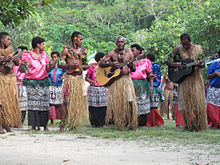
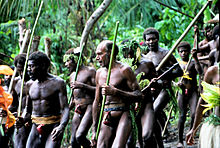
Melanesia generally includes New Guinea and other (far-)western Pacific islands from the Arafura Sea out to Fiji. The region is mostly inhabited by the Melanesian peoples.
- Melanesians
- Austronesian-speaking Melanesians
- Fijians (iTaukei): Fiji
- Kanak: New-Caledonia
- Malaitan people: Malaita, Solomon Islands
- Ni-Vanuatu: Vanuatu
- Papuan-speaking Melanesians
- Austronesian-speaking Melanesians
- Papuans: more than 250 distinct tribes or clans, each with their own language and culture. The main island of New Guinea and surrounding islands (territory forming independent state of Papua New Guinea (PNG) and the Indonesian provinces of West Papua and Papua). Considered "Indigenous" these people are a subject to many debates.
- Sepik peoples
- Kwoma: Peilungua Mountains, Papua New Guinea.
- Iatmul: Sepik, Papua New Guinea.
- Sepik Hill
- Sanio
- Hewa: Southern Highlands, PNG
- Sanio
- Trans New-Guinean peoples
- Huli of the Southern Highlands, Papua New Guinea.
- Angu: Southwestern Morobe Province, Papua New Guinea.
- Bosavi
- Kaluli-Kasua
- Kaluli: Great Papuan Plateau, PNG
- Kaluli-Kasua
- Ok
- Mountain Ok
- Wopkaimin: western PNG, Star Mountains.
- Mountain Ok
- West Trans New-Guinean peoples
- Dani: Papua, Indonesia
- Korowai: West Papua, close to the Papua New Guinea border.
- Asmat: Asmat Regency, West Papua.
- Sepik peoples
Micronesia
[edit]Micronesia generally includes the various small island chains of the western and central Pacific. The region is mostly inhabited by the Micronesian peoples.
Polynesia
[edit]This article needs additional citations for verification. (December 2021) |


Polynesia includes New Zealand and the islands of Oceania, and has various Indigenous populations.[118]
- Native Hawaiians[119]
- Tongans[119]
- Tuvaluan people
- Marquesas Islanders
- Rapanui
- Samoans
- Tokelau
- Austral Islanders
- Cook Islanders
- Maohi, Tahiti
- Māori, New Zealand
- Moriori, Chatham Islands
- Tahitians, French Polynesia
- Tuamotus
- Niueans
- Vanuatuans[b]
- Kapingamarangi and Nukuoro, The Federated States of Micronesia
- Rennel, Tikopia and Vaeakau-Taumako, Solomon Islands
- Nuguria, Papua New Guinea
- Nukumanu, Papua New Guinea
- Takuu, Papua New Guinea
- Ontong Java
- Sikaiana
- Anuta, Solomon Islands
- Fagauvea, Ouvéa, New Caledonia
- Aniwa
- Bellona
- Rennel
Circumpolar
[edit]Circumpolar peoples is an umbrella term for the various Indigenous peoples of the Arctic.
List of peoples by ethnolinguistic grouping:
- "Paleosiberian"
- Chukotko-Kamchatkan
- Chukchi (Lyg'oravetl'et/O'ravetl'et): Siberia, Russian Far East, Russia
- Koryaks (Nymylan-Chauchuven): Russian Far East
- Tungusic
- Chukotko-Kamchatkan
- Eskimo–Aleut
- Aleut (Unangax): Aleutian Islands and Kamchatka Krai
- Eskimo/Yupik-Inuit
- Yupik: Alaska, United States and the Russian Far East, Siberia
- Alutiiq (Sugpiat): Alaska, United States
- Yup'ik (Yupiat/Yupiit/Cup'ik/Cupiit): Alaska, United States
- Cup'ig (Nunivak Cup'ig people): Nunivak Island (Alaska), United States
- Siberian Yupik (Yupighyt): Siberia, Russia
- Inuit: Greenland, Northern Canada (Nunavut, Nunavik and Northwest Territories), Alaska, United States
- Inupiat (Iñupiat): Alaska's Arctic and North Slope boroughs and the Bering Straits
- Kalaallit (Kalaallit): Greenland
- Yupik: Alaska, United States and the Russian Far East, Siberia
- Turkic
- Northeast Turks
- Dolgans (Dolgan/Tya Kikhi): Siberia (Krasnoyarsk Krai), Russia
- Yakuts (Sakha): Siberia (Sakha Republic), Russia
- Northeast Turks
- Ugrians, Yugra, Siberia, Russia
- Sami (Sámi/Saami/Lapp), formerly known by the exonym Lapps: Northern Norway, Sweden, Finland, and Kola Peninsula in Russia
- Samoyedic peoples
- Northern Samoyedic peoples: West Siberia and Far Northern European Russia
- Enets (Entsi): Far Northern Western Siberia, Russia
- Nenets (Neney Neneche): Far Northern Western Siberia and Far Northern European Russia
- Nganasan (Ŋənəhsa(nəh)): Taymyr Peninsula, Siberia, Russia
- Northern Samoyedic peoples: West Siberia and Far Northern European Russia
- Yukaghirs (Odul/Vadul/Detkil'): Far Northern East Siberia, Russia
See also
[edit]- Center for World Indigenous Studies
- Declaration on the Rights of Indigenous Peoples
- Indigenous peoples
- Indigenous archaeology
- Indigenous Dialogues
- Indigenous (ecology)
- Indigenous intellectual property
- Indigenous knowledge
- Indigenous language
- Indigenous medicine
- Indigenous music
- International Work Group for Indigenous Affairs
- United Nations Permanent Forum on Indigenous Issues
- World Council of Indigenous Peoples
- Working Group on Indigenous Populations
- List of contemporary ethnic groups
- Lists of people by nationality
- List of indigenous rights organizations
- See all pages that start with indigenous people or indigenous
References
[edit]Notes
[edit]- ^ Also known as First peoples, First nations, Aboriginal peoples, Native peoples, Indigenous Natives, or Autochthonous peoples. Since 2020, most style guides have recommend capitalization of "Indigenous" when referring to specific Indigenous peoples as ethnic groups, nations, and the citizens or members of these groups.[121][122][123][124][125]
- ^ The Indigenous people of Vanuatu make up more than 95 percent of a country of just under a quarter of a million people (who speak more than 111 different languages), recognized by the United Nations as simultaneously having Least Developed status and having the world’s greatest cultural and linguistic diversity.[120]
Citations
[edit]- ^ United Nations Human Rights, Office of the High Commissioner (2013). "Indigenous Peoples and the United Nations Human Rights System, Fact Sheet No. 9/Rev.2". United Nations. p. 2. Retrieved 29 December 2023.
- ^ "Indigenous and Tribal People's Rights Over Their Ancestral Lands and Natural Resources". cidh.org. Archived from the original on 1 June 2020. Retrieved 30 May 2020.
- ^ McIntosh, Ian (September 2000). "Are there Indigenous Peoples in Asia?". Cultural Survival Quarterly Magazine. Archived from the original on 22 April 2021. Retrieved 1 April 2021.
- ^ a b Secretariat of the Permanent Forum on Indigenous Issues 2009, p. 6.
- ^ Muckle, Robert J. (2012). Indigenous Peoples of North America: A Concise Anthropological Overview. University of Toronto Press. p. 18. ISBN 978-1-4426-0416-2.
- ^ "Indigenous Peoples and the United Nations Human Rights System" (PDF). United Nations. p. 2. Retrieved 21 May 2023.
- ^ Acharya, Deepak and Shrivastava Anshu (2008): Indigenous Herbal Medicines: Tribal Formulations and Traditional Herbal Practices, Aavishkar Publishers Distributor, Jaipur, India. ISBN 978-81-7910-252-7. p. 440
- ^ UNHR Fact Sheet No. 9 2013, p. 3.
- ^ Taylor Saito, Natsu (2020). "Unsettling Narratives". Settler Colonialism, Race, and the Law: Why Structural Racism Persist (eBook). NYU Press. ISBN 978-0-8147-0802-6. Archived from the original on 15 March 2023. Retrieved 21 December 2020.
...several thousand nations have been arbitrarly (and generally involuntarily) incorporated into approximately two hundred political constructs we call independent states...
- ^ Miller, Robert J.; Ruru, Jacinta; Behrendt, Larissa; Lindberg, Tracey (2010). Discovering Indigenous Lands: The Doctrine of Discovery in the English Colonies. OUP Oxford. pp. 9–13. ISBN 978-0-19-957981-5.
- ^ UNHR Fact Sheet No. 9 2013, p. 9.
- ^ Bodley 2008, p. 2.
- ^ UNHR Fact Sheet No. 9 2013, p. 4.
- ^ Jose R. Martinez Cobo
- ^ Definition of indigenous peoples
- ^ Hakansson, N. Thomas (1994). "The Detachability of Women: Gender and Kinship in Processes of Socioeconomic Change among the Gusii of Kenya". American Ethnologist. 21 (3): 516–538. doi:10.1525/ae.1994.21.3.02a00040. JSTOR 645919.
- ^ Maxon, R.M. (1976). "Gusii Oral Texts and the Gusii Experience under British Rule". The International Journal of African Historical Studies. 9 (1): 74–80. doi:10.2307/217392. JSTOR 217392.
- ^ Snyder, Katherine A. (2006). "Mothers on the March: Iraqw Women Negotiating the Public Sphere in Tanzania". Africa Today. 53 (1): 79–99. doi:10.1353/at.2006.0064. JSTOR 4187757. S2CID 144707308.
- ^ Boone, Catherine; Nyeme, Lydia (2015). "Land Institutions and Political Ethnicity in Africa: Evidence from Tanzania". Comparative Politics. 48 (1): 67–86. doi:10.5129/001041515816075123. JSTOR 43664170.
- ^ a b Boone, Catherine (2012). "Land Conflict and Distributive Politics in Kenya". African Studies Review. 55 (1): 75–103. doi:10.1353/arw.2012.0010. hdl:2152/19778. JSTOR 41804129. S2CID 154334560.
- ^ Jungerius, P. D. (1998). "Indigenous knowledge of landscape-ecological zones among traditional herbalists: a case study in Keiyo District, Kenya". GeoJournal. 44 (1): 51–60. doi:10.1023/A:1006851813051. JSTOR 41147169. S2CID 128857738.
- ^ McGlashan, Neil (1964). "Indigenous Kikuyu Education". African Affairs. 63 (250): 47–57. doi:10.1093/oxfordjournals.afraf.a095163. JSTOR 719766.
- ^ Castro, Alfonso Peter (1991). "Indigenous Kikuyu Agroforestry: A Case Study of Kirinyaga, Kenya". Human Ecology. 19 (1): 1–18. doi:10.1007/BF00888974. JSTOR 4602996. S2CID 154663699.
- ^ Kubow, Patricia K. (2007). "Teachers' Constructions of Democracy: Intersections of Western and Indigenous Knowledge in South Africa and Kenya". Comparative Education Review. 51 (3): 307–328. doi:10.1086/518479. JSTOR 10.1086/518479. S2CID 145758842.
- ^ Crowley, Eve L.; Carter, Simon E. (2000). "Agrarian Change and the Changing Relationships between Toil and Soil in Maragoli, Western Kenya (1900-1994)". Human Ecology. 28 (3): 383–414. doi:10.1023/A:1007005514841. JSTOR 4603359. S2CID 146217282.
- ^ Hodgson, Dorothy (2011). Being Maasai, Becoming Indigenous: Postcolonial Politics in a Neoliberal World. Indiana University Press. ISBN 9780253223050.
- ^ Shani, Serah (2022). Indigenous Elites in Africa: The Case of Kenya's Maasai. Routledge, Taylor & Francis. ISBN 9781032025766.
- ^ "The indigenous Maasai wanted to secure plots for farming in their home villages" (p. 29). Ibrahim, Barbara; Ibrahim, Fouad N. (1995). "Pastoralists in Transition - A Case Study from Lengijape, Maasai Steppe". GeoJournal. 36 (1): 27–48. doi:10.1007/BF00812524. JSTOR 41146468. S2CID 154884572.
- ^ Sifuna, Daniel (1984). "Indigenous Education in Nomadic Communities : A Survey of The Samburu, Rendille, Gabra and Boran of Northern Kenya". Présence Africaine Nouvelle. 131 (3e): 66–88. doi:10.3917/presa.131.0066. JSTOR 24350929.
- ^ Campbell, John R. (2004). "Ethnic minorities and development: A prospective look at the situation of African pastoralists and hunter-gatherers". Ethnicities. 4 (1): 5–26. doi:10.1177/1468796804040326. JSTOR 23890130. S2CID 145416864.
- ^ Holtzman, Jon D. (2003). "In a Cup of Tea: Commodities and History among Samburu Pastoralists in Northern Kenya". American Ethnologist. 30 (1): 136–155. doi:10.1525/ae.2003.30.1.136. JSTOR 3805213.
- ^ "Eritrean Afar People". Eritrean Afar National Congress. Archived from the original on 2022-01-04. Retrieved 2022-01-04.
- ^ Steven L. Danver (2015). Native Peoples of the World: An Encyclopedia of Groups, Cultures and Contemporary Issues. Routledge. pp. 601–603, 610. ISBN 978-1-317-46400-6.
- ^ Beall, Cynthia M. (2014). "Adaptation to High Altitude: Phenotypes and Genotypes". Annual Review of Anthropology. 43: 251–272. doi:10.1146/annurev-anthro-102313-030000. JSTOR 43049574.
- ^ Young, John (1999). "Along Ethiopia's Western Frontier: Gambella and Benishangul in Transition". The Journal of Modern African Studies. 37 (2): 321–346. doi:10.1017/S0022278X9900302X. JSTOR 161849. S2CID 155057210.
- ^ Sanches, Edalina Rodrigues (2022). Popular Protest, Political Opportunities, and Change in Africa. Routledge. pp. 181–2. doi:10.4324/9781003177371-11. ISBN 9781003177371. S2CID 246711828.
...recognition of the identity of indigenous Amhara people from Welkait as Amhara
- ^ John, Sonja (2021-09-13). "Civil rights activists in Welkait give hope for peace and democracy in Ethiopia". Africa at LSE. Retrieved 2022-02-20.
They requested state institutions recognise their indigenous Amhara identity and end discrimination.
- ^ a b Donham, Donald L. (1992). "Revolution and Modernity in Maale: Ethiopia, 1974 to 1987". Comparative Studies in Society and History. 34 (1): 28–57. doi:10.1017/S0010417500017424. JSTOR 178984. S2CID 143440554.
- ^ Lydall, Jean (2000). "The Threat of the HIV/AIDS Epidemic in South Omo Zone, Southern Ethiopia". Northeast African Studies. Special Issue: HIV/AIDS in Ethiopia, Part I: Risk and Preventive Behavior, Sexuality, and Opportunistic Infections. 7 (1): 41–61. doi:10.1353/nas.2004.0007. JSTOR 41931329. S2CID 143405452.
- ^ Azeze, Fekade (2001). "The State of Oral Literature Research in Ethiopia: Retrospect and Prospect". Journal of Ethiopian Studies. 34 (1): 43–85. JSTOR 41966115.
- ^ Jedrej, M. C. (1975). "Ingessana Throwing Knives (Sudan)". Anthropos. Bd. 70, H. 1./2. 70 (1/2): 42–48. JSTOR 40458698.
- ^ Jedrej, M. C. (2004). "The Southern Funj of the Sudan as a Frontier Society, 1820-1980". Comparative Studies in Society and History. 46 (4): 709–729. doi:10.1017/S0010417504000337. JSTOR 3879507. S2CID 145732712.
- ^ Amborn, Hermann; Schubert, Ruth (2006). "The Contemporary Significance of What Has Been. Three Approaches to Remembering the past: Lineage, Gada, and Oral Tradition". History in Africa. 33: 53–84. doi:10.1353/hia.2006.0004. JSTOR 20065765. S2CID 162724953.
- ^ a b Debelo, Asebe Regassa; Jirata, Tadesse Jaleta (2018). ""Peace Is Not a Free Gift": Indigenous Conceptions of Peace among the Guji-Oromo in Southern Ethiopia". Northeast African Studies. 18 (1–2): 201–230. doi:10.14321/nortafristud.18.1-2.0201. JSTOR 10.14321/nortafristud.18.1-2.0201. S2CID 203104277.
- ^ Merid, Takele (2019). "Indigenous Ecological Knowledge and the Changing Livelihood Strategies of the Gedeo People". Journal of Ethiopian Studies. 52: 139–166. JSTOR 48619998.
- ^ Donovan, Dolores A.; Assefa, Getachew (2003). "Homicide in Ethiopia: Human Rights, Federalism, and Legal Pluralism". The American Journal of Comparative Law. 51 (3): 505–552. doi:10.2307/3649118. JSTOR 3649118.
- ^ Meckelburg, Alexander (2015). "Slavery, Emancipation, and Memory: Exploratory Notes on Western Ethiopia". The International Journal of African Historical Studies. Special Issue: Exploring Post-Slavery in Contemporary Africa. 48 (2): 345–362. JSTOR 44723364.
- ^ a b c Fratkin, Elliot (2014). "Ethiopia's Pastoralist Policies: Development, Displacement and Resettlement". Nomadic Peoples. Special issue: The Emerging World of Pastoralists and Nomads. 18 (1): 94–114. doi:10.3197/np.2014.180107. JSTOR 43124163. S2CID 147312991.
- ^ Strecker, Ivo (2007). "A Hamar Spokesman on German Television and Radio: lessons on cultural difference and similarity". Journal of Ethiopian Studies. 40 (1/2): 181–201. JSTOR 41988226.
- ^ a b Pankhurst, Alula (2002). "Research on Ethiopian societies and cultures during the second half of the twentieth century". Journal of Ethiopian Studies. 35 (2): 1–60. JSTOR 41966134.
- ^ a b Jalata, Asafa (2017). "The Oromo Movement: The Effects of State Terrorism and Globalization in Oromia and Ethiopia". Social Justice. 44 (4): 83–106. JSTOR 26538396.
- ^ a b Naty, Alexander (2002). "Environment, Society and the State in Western Eritrea". Africa: Journal of the International African Institute. 72 (4): 569–597. doi:10.3366/afr.2002.72.4.569. JSTOR 3556702. S2CID 142770729.
- ^ a b Woldemikael, Tekle M. (2003). "Language, Education, and Public Policy in Eritrea". African Studies Review. 46 (1): 117–136. doi:10.2307/1514983. JSTOR 1514983. S2CID 143172927.
- ^ Donham, Donald L. (2000). "On Being "First": Making History by Two's in Southern Ethiopia". Northeast African Studies. Special Issue: Cultural Variation and Social Change in Southern Ethiopia: Comparative Approaches. 7 (3): 21–33. doi:10.1353/nas.2005.0005. JSTOR 41931255. S2CID 144593095.
- ^ Turton, David (1992). ""We Must Teach Them to Be Peaceful": Mursi views on being human and being Mursi". Nomadic Peoples. 31 (31): 19–33. JSTOR 43123371.
- ^ Weldehaimanot, Simon M; Mekonnen, Daniel R (2012). "Favourable Awards to Trans-Boundary Indigenous Peoples". Australian Indigenous Law Review. 16 (1): 60–76. JSTOR 26423239.
- ^ Tewolde, Azeb (2018). "The Archives of Eritrea as a Primary Source of Information for the Eritrean Cultural Heritage: Its Nature and Accessibility". Rassegna di Studi Etiopici. 3a Serie. 2 (49): 11–22. JSTOR 48564342.
- ^ Bender, M. L. (1971). "The Languages of Ethiopia: A New Lexicostatistic Classification and Some Problems of Diffusion". Anthropological Linguistics. 13 (5): 165–288. JSTOR 30029540.
- ^ Quinlan, Marsha B.; Quinlan, Robert J.; Dira, Samuel Jilo (2014). "Sidama Agro-Pastoralism and Ethnobiological Classification of its Primary Plant, Enset (Ensete ventricosum)". Ethnobiology Letters. 5: 116–125. doi:10.14237/ebl.5.2014.222. JSTOR 26423590.
- ^ Hamer, John H. (2002). "The Religious Conversion Process among the Sidāma of North-East Africa". Africa: Journal of the International African Institute. 72 (4): 598–627. doi:10.3366/afr.2002.72.4.598. JSTOR 3556703. S2CID 143489496.
- ^ William T. W., Morgan (2000). "The Ethnic Geography of Kenya on the Eve of Independence: The 1962 Census (Ethnogeographie Kenias am Vorabend der Unabhängigkeit: Der Zensus von 1962)". Erdkunde. 54 (1): 76–87. doi:10.3112/erdkunde.2000.01.07. JSTOR 25647252.
- ^ Bouh, Ahmed Mohammed; Mammo, Yared (2008). "Indigenous Conflict Management and Resolution Mechanisms on Rangelands in Somali Regional State, Ethiopia". Nomadic Peoples. 12 (1): 109–121. doi:10.3167/np.2008.120107. JSTOR 43123815.
- ^ "Ethiopian Tribeswomen Seek to Attract Favourable Husbands With Lip Plates". Al Bawaba. 2020-06-24. Retrieved 2022-02-15.
- ^ a b Abbink, J. (2000). "Violence and the Crisis of Conciliation: Suri, Dizi and the State in South-West Ethiopia". Africa: Journal of the International African Institute. 70 (4): 527–550. doi:10.3366/afr.2000.70.4.527. hdl:1887/9482. JSTOR 1161471. S2CID 145471725.
- ^ Rahmato, Dessalegn (1995). "Resilience and Vulnerability: Enset Agriculture in Southern Ethiopia". Journal of Ethiopian Studies. 28 (1): 23–51. JSTOR 41966054.
- ^ International Crisis Group (2009-09-04). "V. Contested Multi-Ethnic Politics". Ethiopia: Ethnic Federalism and Its Discontents. International Crisis Group. pp. 22–28.
{{cite book}}:|journal=ignored (help) - ^ Habtu, Alem (2005). "Multiethnic Federalism in Ethiopia: A Study of the Secession Clause in the Constitution". Publius. 35 (5): 313–335. doi:10.1093/publius/pji016. JSTOR 4624714.
- ^ Douny, Laurence (2018). "The Commodification of Authenticity: Performing and Displaying Dogon Material Identity". In Bunten, Alexis Celeste; Graburn, Nelson H.H. (eds.). Indigenous Tourism Movements. University of Toronto Press. ISBN 9781442628298. Retrieved 2024-05-30.
- ^ Danver, Steven L. (2015). Native Peoples of the World: An Encyclopedia of Groups, Cultures and Contemporary Issues. Taylor & Francis. p. 29. ISBN 9781317464006. Retrieved 2024-05-30.
- ^ Williams, Victoria R. (2020). Indigenous Peoples: An Encyclopedia of Culture, History, and Threats to Survival. Bloomsbury Publishing. p. 425. ISBN 9798216102199. Retrieved 2024-05-30.
- ^ a b Williams, Victoria R. (2020). Indigenous Peoples: An Encyclopedia of Culture, History, and Threats to Survival. Bloomsbury Publishing. p. 429. ISBN 9798216102199. Retrieved 2024-05-30.
- ^ a b Pierret, Paul, "Dictionnaire d'archéologie égyptienne", Imprimerie nationale 1875, p. 198-199 [in] Diop, Cheikh Anta, "Precolonial Black Africa", (trans: Harold Salemson), Chicago Review Press (1988), p. 65
- ^ Unrepresented Nations and People Organization | UNPO, Assyrians the Indigenous People of Iraq [1]
- ^ Sawahla & Dloomy (2007, pp. 425–433)
- ^ Williams, Victoria R. (2020-02-24). Indigenous Peoples: An Encyclopedia of Culture, History, and Threats to Survival [4 volumes]. ABC-CLIO. ISBN 978-1-4408-6118-5.
- ^ Tubb, 1998. pg 13–14.
- ^ Mark Smith, in The Early History of God: Yahweh and Other Deities of Ancient Israel, states "Despite the long regnant model that the Canaanites and Israelites were people of fundamentally different culture, archaeological data now casts doubt on this view. The material culture of the region exhibits numerous common points between Palestinians and Canaanites in the Iron I period (c. 1200–1000 BC). The record would suggest that the Israelite culture largely overlapped with and derived from Canaanite culture. ... In short, Israelite culture was largely Canaanite in nature. Given the information available, one cannot maintain a radical cultural separation between Canaanites and Palestinians for the Iron I period." (pp. 6–7). Smith, Mark (2002) The Early History of God: Yahweh and Other Deities of Ancient Israel (Eerdman's)
- ^ Rendsberg, Gary (2008). "Israel without the Bible". In Frederick E. Greenspahn. The Hebrew Bible: New Insights and Scholarship. NYU Press, pp. 3–5
- ^ Erich S. Gruen, Diaspora: Jews Amidst Greeks and Romans Harvard University Press, 2009 pp. 3–4, 233–34: 'Compulsory dislocation, .…cannot have accounted for more than a fraction of the diaspora. … The vast bulk of Jews who dwelled abroad in the Second Temple Period did so voluntarily.' (2)' .Diaspora did not await the fall of Jerusalem to Roman power and destructiveness. The scattering of Jews had begun long before-occasionally through forced expulsion, much more frequently through voluntary migration.'
- ^ Josephus. War of the Jews 9:2.
- ^ "Jewish Genetics - DNA, genes, Jews, Ashkenazi".
- ^ Haber, Marc; Gauguier, Dominique; Youhanna, Sonia; Patterson, Nick; Moorjani, Priya; Botigué, Laura R; Platt, Daniel E; Matisoo-Smith, Elizabeth; Soria-Hernanz, David F; Wells, R. Spencer; Bertranpetit, Jaume; Tyler-Smith, Chris; Comas, David; Zalloua, Pierre A (2013). "Genome-Wide Diversity in the Levant Reveals Recent Structuring by Culture". PLOS Genetics. 9 (2): e1003316. doi:10.1371/journal.pgen.1003316. PMC 3585000. PMID 23468648.
- ^ Behar, Doron M.; Yunusbayev, Bayazit; Metspalu, Mait; Metspalu, Ene; Rosset, Saharon; Parik, Jüri; Rootsi, Siiri; Chaubey, Gyaneshwer; Kutuev, Ildus; Yudkovsky, Guennady; Khusnutdinova, Elza K.; Balanovsky, Oleg; Semino, Ornella; Pereira, Luisa; Comas, David; Gurwitz, David; Bonne-Tamir, Batsheva; Parfitt, Tudor; Hammer, Michael F.; Skorecki, Karl; Villems, Richard (2010). "The genome-wide structure of the Jewish people". Nature. 466 (7303): 238–242. Bibcode:2010Natur.466..238B. doi:10.1038/nature09103. PMID 20531471. S2CID 4307824.
- ^ "Tracing the Roots of Jewishness". 2010-06-03.
- ^ Busbridge, Rachel (1 January 2018). "Israel-Palestine and the Settler Colonial 'Turn': From Interpretation to Decolonization". Theory, Culture & Society. 35 (1): 91–115. doi:10.1177/0263276416688544. ISSN 0263-2764. S2CID 151793639.
- ^ Ukashi, Ran (1 May 2018). "Zionism, Imperialism, and Indigeneity in Israel/Palestine: A Critical Analysis". Peace and Conflict Studies. 25 (1). doi:10.46743/1082-7307/2018.1442. ISSN 1082-7307.
- ^ Goldberg, Carole (14 April 2020). "Invoking the Indigenous, for and against Israel". Swimming against the Current. Academic Studies Press. pp. 298–318. doi:10.1515/9781644693087-019. ISBN 978-1-64469-308-7. S2CID 243669197.
- ^ Troen, Ilan; Troen, Carol (2019). "Indigeneity". Israel Studies. 24 (2): 17–32. doi:10.2979/israelstudies.24.2.02. ISSN 1084-9513. JSTOR 10.2979/israelstudies.24.2.02. S2CID 239062214.
- ^ Kattan, Victor. "'Invented' Palestinians, 'Indigenous' Jews: The Roots of Israel's Annexation Plan, and Why the World Must Stop Netanyahu, Before It's Too Late". Haaretz.
- ^ Pappe, Ilan (1 January 2018). "Indigeneity as Cultural Resistance: Notes on the Palestinian Struggle within Twenty-First-Century Israel". South Atlantic Quarterly. 117 (1): 157–178. doi:10.1215/00382876-4282082. hdl:10871/28176. ISSN 0038-2876.
- ^ Frantzman, Seth J.; Yahel, Havatzelet; Kark, Ruth (2012). "Contested Indigeneity: The Development of an indigenous Discourse on the Bedouin of the Negev, Israel". Israel Studies. 17 (1): 78–104. doi:10.2979/israelstudies.17.1.78. ISSN 1527-201X. S2CID 143785060.
- ^ Yiftachel, Oren; Roded, Batya; Kedar, Alexandre (Sandy) (1 November 2016). "Between rights and denials: Bedouin indigeneity in the Negev/Naqab". Environment and Planning A: Economy and Space. 48 (11): 2129–2161. Bibcode:2016EnPlA..48.2129Y. doi:10.1177/0308518X16653404. ISSN 0308-518X. S2CID 147970455.
- ^ Tatour, Lana (26 November 2019). "The culturalisation of indigeneity: the Palestinian-Bedouin of the Naqab and indigenous rights". The International Journal of Human Rights. 23 (10): 1569–1593. doi:10.1080/13642987.2019.1609454. ISSN 1364-2987. S2CID 150663547.
- ^ The UN Refugee Agency | UNHCR, World Directory of Minorities and Indigenous Peoples [2]
- ^ Department of Evolutionary Biology at University of Tartu Estonian Biocentre | Reconstruction of Patrilineages and Matrilineages of Samaritans and Other Israeli Populations From Y-Chromosome and Mitochondrial DNA Sequence Variation, Molecular Anthropology Group [3]
- ^ Williams, Victoria R. (2020). "Talysh". Indigenous Peoples: An Encyclopedia of Culture, History, and Threats to Survival [4 Volumes]. Santa Barbara, California: ABC-CLIO. p. 1016. ISBN 9781440861185.
- ^ Szczśniak, Andrew L. (1963). "A Brief Index of Indigenous Peoples and Languages of Asiatic Russia". Anthropological Linguistics. 5 (6): 1–29. ISSN 0003-5483. JSTOR 30022425.
- ^ Udayon, Misra (1987). "Immigration and Identity Transformation in Assam". Economic and Political Weekly. 34 (21): 1266. JSTOR 4407987. Retrieved 2024-06-07.
Census official C S Mullan's observations in the 1931 Census Report where he predicted that if the immigrations went on unchecked, the indigenous Assamese would be outnumbered in all but one or two Upper Assam districts, brought to the fore the threat to the Assamese identity.
- ^ Baruah, Sanjib (1986). "Immigration, Ethnic Conflict, and Political Turmoil--Assam, 1979-1985". Asian Survey. 26 (11): 1187–88. doi:10.2307/2644315. JSTOR 2644315. Retrieved 2024-06-07.
Even without immigration, Assam's indigenous population is extremely diverse in cultural, linguistic, and religious terms. [...] Of the languages that appear in Table 2, Assamese is an indigenous language.
- ^ "Orang Asli in Peninsular Malaysia : Population, Spatial Distribution and Socio-Economic Condition" (PDF).
- ^ "World Directory of Minorities and Indigenous Peoples – Philippines: Overview, 2007", UNHCR | Refworld.
- ^ Hanihara, T (1992). "Negritos, Australian Aborigines, and the proto-sundadont dental pattern: The basic populations in East Asia". American Journal of Physical Anthropology. 88 (2): 183–96. doi:10.1002/ajpa.1330880206. PMID 1605316.
- ^ Agpaoa, Joshua C. (2013). Design Motifs of the Northern Philippine Textiles.
- ^ Baer, Lars-Anders (2005). "The Rights of Indigenous Peoples – A Brief Introduction in the Context of the Sámi". International Journal on Minority and Group Rights. 12 (2/3): 245–267. doi:10.1163/157181105774740589. JSTOR 24675300.
- ^ Gouverneur, Cédric (1 January 2017). "Europe's only indigenous people". Le Monde Diplomatique. Retrieved 28 August 2023.
- ^ "Europe's only recognized indigenous peoples live in Sweden". Swedish Development Forum. 27 March 2018. Retrieved 28 August 2023.
- ^ "The Sámi: The People, Their Culture and Languages". Council of Europe. 2015. Retrieved 28 August 2023.
- ^ "Rights of the Sámi People". Finnish Ministry of Justice. Retrieved 28 August 2023.
- ^ Jaakkola, Jouni J. K.; Juntunen, Suvi; Näkkäläjärvi, Klemetti (2018). "The Holistic Effects of Climate Change on the Culture, Well-Being, and Health of the Saami, the Only Indigenous People in the European Union". Current Environmental Health Reports. 5 (4): 401–417. doi:10.1007/s40572-018-0211-2. PMC 6306421. PMID 30350264.
- ^ Valkonen, Sanna; Valkonen, Jarno (2017). "The Non-State Sámi". In Wiesner, Claudia; Björk, Anna; Kivistö, Hanna-Mari; Mäkinen, Katja (eds.). Shaping Citizenship: A Political Concept in Theory, Debate and Practice. Routledge. pp. 138–152. doi:10.4324/9781315186214-11. ISBN 9781315186214.
- ^ Grote, Rainer (2006). "On the Fringes of Europe: Europe's Largely Forgotten Indigenous Peoples". American Indian Law Review. 31 (2): 425–443. doi:10.2307/20070794. JSTOR 20070794.
- ^ "Sápmi - IWGIA - International Work Group for Indigenous Affairs". www.iwgia.org. Retrieved 2024-02-23.
- ^ "Samoyed:eHRAF World Cultures". ehrafworldcultures.yale.edu. Retrieved 2024-02-23.
- ^ a b c Fremer, Iana (2021). "Ukraine: New Law Determines Legal Status of Indigenous People". Library of Congress. Retrieved 2023-08-04.
- ^ "Refworld | World Directory of Minorities and Indigenous Peoples - Ireland : Travellers". Archived from the original on 26 January 2023. Retrieved 25 August 2022.
- ^ "Irish Traveller Movement - About Irish Travellers". Archived from the original on 29 September 2022. Retrieved 28 October 2022.
- ^ Rouse (1992)
- ^ Gagné, Natacha; Salaün, Marie (2012). "Appeals to indigeneity: insights from Oceania". Social Identities. 18 (4): 381–398. doi:10.1080/13504630.2012.673868. S2CID 144491173.
- ^ a b O. Ka'ili, Tevita (2017). Marking Indigeneity: The Tongan Art of Sociospatial Relations. University of Arizona Press. ISBN 9780816530564.
- ^ Geismar, Haidy (2020). "Introduction: Culture, Property, Indigeneity". Treasured Possessions. p. 1. doi:10.1515/9780822399704-004. ISBN 9780822399704. S2CID 241275292.
- ^ "APA Style - Racial and Ethnic Identity". Section 5.7 of the APA Publication Manual, Seventh Edition. Associated Press. 2019-11-01. Archived from the original on 15 March 2023. Retrieved 2022-02-03.
Racial and ethnic groups are designated by proper nouns and are capitalized. ... capitalize terms such as "Native American," "Hispanic," and so on. Capitalize "Indigenous" and "Aboriginal" whenever they are used. Capitalize "Indigenous People" or "Aboriginal People" when referring to a specific group (e.g., the Indigenous Peoples of Canada), but use lowercase for "people" when describing persons who are Indigenous or Aboriginal (e.g., "the authors were all Indigenous people but belonged to different nations")
- ^ "Reporter's Indigenous Terminology Guide". The Native American Journalists Association. Archived from the original on 2018-11-16. Retrieved 2022-02-02.
- ^ "NAJA AP Style Guide". The Native American Journalists Association. Archived from the original on 18 December 2018. Retrieved 2022-02-02.
- ^ "Editorial Guide". Indian Affairs. US Bureau of Indian Affairs. Archived from the original on 18 January 2023. Retrieved 2023-02-14.
The term "indigenous" is a common synonym for the term "American Indian and Alaska Native" and "Native American." But "indigenous" doesn't need to be capitalized unless it's used in context as a proper noun.
- ^ "FAQ Item: Capitalization". The Chicago Manual of Style Online. Archived from the original on 26 November 2022. Retrieved 2023-02-14.
We would capitalize "Indigenous" in both contexts: that of Indigenous people and groups, on the one hand, and Indigenous culture and society, on the other.
Sources
[edit]- Bodley, John H. (2008). Victims of Progress (5th ed.). Plymouth, England: AltaMira Press. ISBN 978-0-7591-1148-6.
- Kipuri, Naomi (2007). "Kenya". In Sille Stidsen (compilation and ed.) (ed.). The Indigenous World 2007. International Work Group for Indigenous Affairs yearbooks. Marianne Wiben Jensen (Horn of Africa and East Africa regional ed.). Copenhagen: IWGIA, distributed by Transaction Publishers. pp. 468–476. ISBN 978-87-91563-23-2. ISSN 1024-0217. OCLC 30981676. Archived from the original (PDF online edition) on 2008-10-22.
{{cite book}}:|journal=ignored (help) - Minority Rights Group International (1997), World Directory of Minorities, London, UK: Minority Rights Group International, ISBN 978-1-873194-36-2
- Rouse, Irving (1992), The Tainos: Rise and Decline of the People who greeted Columbus, New Haven, Connecticut: Yale University Press, ISBN 978-0-300-05181-0, OCLC 24469325
- Secretariat of the Permanent Forum on Indigenous Issues (2009). State of the World's Indigenous Peoples. New York: United Nations. pp. 4–7.
- Tubb, Jonathan N. (1998). Canaanites. University of Oklahoma Press. p. 40. ISBN 978-0-8061-3108-5.
The Canaanites and Their Land.














